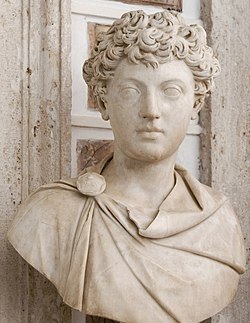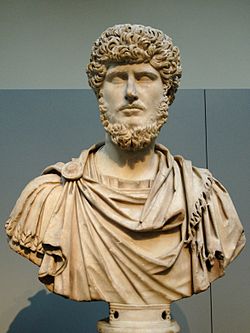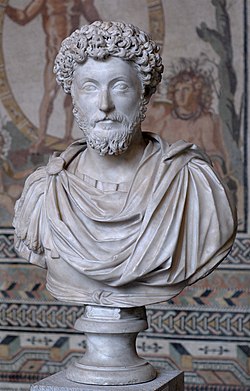مƒمƒ«م‚¯م‚¹مƒ»م‚¢م‚¦مƒ¬مƒھم‚¦م‚¹مƒ»م‚¢مƒ³مƒˆمƒ‹مƒŒم‚¹
مƒمƒ«م‚¯م‚¹مƒ»م‚¢م‚¦مƒ¬مƒھم‚¦م‚¹مƒ»م‚¢مƒ³مƒˆمƒ‹مƒŒم‚¹ï¼ˆهڈ¤ه…¸مƒ©مƒ†مƒ³èھï¼ڑMarcus Aurelius Antoninus [notes 1]121ه¹´4وœˆ26و—¥ - 180ه¹´3وœˆ17و—¥[3])مپ¯م€پ第16ن»£مƒمƒ¼مƒçڑ‡ه¸مپ§مپ‚م‚‹م€‚ن؛”è³¢ه¸وœ€ه¾Œمپ®çڑ‡ه¸م€‚第15ن»£çڑ‡ه¸م‚¢مƒ³مƒˆمƒ‹مƒŒم‚¹مƒ»مƒ”م‚¦م‚¹مپ®هگژه¦ƒمƒ•م‚،م‚¦م‚¹مƒ†م‚£مƒٹمƒ»مƒم‚¤مƒ¨مƒ«ï¼ˆه¤§مƒ•م‚،م‚¦م‚¹مƒ†م‚£مƒٹ)مپ®ç”¥مپ§ه…ˆه¸مپ®ه¤–وˆڑمپ«مپ‚مپںم‚ٹم€پمپ¾مپںه¤§مƒ•م‚،م‚¦م‚¹مƒ†م‚£مƒٹمپ¯مƒڈمƒ‰مƒھم‚¢مƒŒم‚¹مپ¨مƒˆمƒ©مƒ¤مƒŒم‚¹مپ®ه‚چç³»è،€و—ڈمپ§م‚‚مپ‚م‚‹م€‚ ه¤–هڈ”父م‚¢مƒ³مƒˆمƒ‹مƒŒم‚¹مپ®çڑ‡ه¥³مپ§è‡ھè؛«مپ®ه¾“ه§‰ه¦¹مپ§مپ‚م‚‹مƒ•م‚،م‚¦م‚¹مƒ†م‚£مƒٹمƒ»مƒںمƒژمƒ«ï¼ˆه°ڈمƒ•م‚،م‚¦م‚¹مƒ†م‚£مƒٹ)مپ¨çµگه©ڑمپ—مپ¦ه¸ن½چم‚’継و‰؟مپ—مپںمپŒم€په…±هگŒçڑ‡ه¸مپ¨مپ—مپ¦مƒڈمƒ‰مƒھم‚¢مƒŒم‚¹مپ®é‡چ臣مپ®هگمƒ«م‚م‚¦م‚¹مƒ»م‚¦م‚§مƒ«م‚¹مپŒç«‹مپ¦م‚‰م‚Œمپ¦مپ„مپںم€‚م‚¢م‚¦مƒ¬مƒھم‚¦م‚¹مپ¯ه°ڈمƒ•م‚،م‚¦م‚¹مƒ†م‚£مƒٹمپ¨مپ®é•·ه¥³مƒ«م‚مƒƒمƒ©م‚’ه«پمپŒمپ›مپ¦ن¸،çڑ‡ه¸مپ®çµگوںم‚’ه›؛م‚پمپںمپŒم€پ169ه¹´مپ«م‚¦م‚§مƒ«م‚¹مپŒه´©ه¾،مپ—مپںن؛‹مپ§هچک独مپ®çڑ‡ه¸مپ¨مپھمپ£مپںم€‚ ه¯¾ه¤–و”؟ç–مپ§مپ¯مƒ‘مƒ«مƒ†م‚£م‚¢مپ¨مپ®وˆ¦ن؛‰مپ«ه‹هˆ©م‚’هڈژم‚پمپںمپŒم€پè›®و—ڈمپ¸مپ®ن؛ˆéک²وˆ¦ن؛‰مپ¨مپ—مپ¦ه§‹م‚پمپںمƒمƒ«م‚³مƒمƒ³مƒ‹ن؛؛م€پم‚¯م‚¢مƒ‡م‚£ن؛؛م€پم‚µمƒ«مƒمƒ†م‚£م‚¢ن؛؛مپھمپ©مپ¸مپ®éپ ه¾پ(مƒمƒ«م‚³مƒمƒ³مƒ‹وˆ¦ن؛‰ï¼‰مپ¯é•·وœںوˆ¦مپ¨مپھم‚ٹم€په›½هٹ›م‚’ç–²ه¼ٹمپ•مپ›م€پè‡ھم‚‰م‚‚陣ن¸مپ§ه´©ه¾،مپ—مپںم€‚ م‚¹مƒˆم‚¢ه“²ه¦مپھمپ©مپ®ه¦èکمپ«é•·مپ‘م€پ良مپڈه›½م‚’و²»م‚پمپںن؛‹مپ‹م‚‰مƒچمƒ«م‚¦م‚،م€پمƒˆمƒ©مƒ¤مƒŒم‚¹م€پمƒڈمƒ‰مƒھم‚¢مƒŒم‚¹م€پم‚¢مƒ³مƒˆمƒ‹مƒŒم‚¹مپ¨ن¸¦مپ¶م€پمپ“مپ®و™‚ن»£مپ®هگچهگ›مپ®ن¸€ن؛؛(ن؛”è³¢ه¸ï¼‰مپ¨è©•ن¾،مپ•م‚Œمپ¦مپ„م‚‹م€‚è»چن؛‹م‚ˆم‚ٹم‚‚ه¦ه•ڈم‚’ه¥½م‚“مپ çڑ‡ه¸مپ¨مپ„مپ†ه§؟مپ¯م€په½¼مپ®è‘—ن½œمپ§مپ‚م‚‹م€ژè‡ھçœپ録م€ڈمپ¸مپ®è©•ن¾،م‚’é€ڑمپکمپ¦ن»ٹو—¥م‚‚ç¶وŒپمپ•م‚Œمپ¦مپ„م‚‹م€‚مپ“م‚Œمپ¯م€ژه›½ه®¶م€ڈم‚’هں·ç†مپ—مپںمƒ—مƒ©مƒˆمƒ³مپ®و™‚ن»£مپ‹م‚‰ه¦èک者مپ«مپ¨مپ£مپ¦çگ†وƒ³مپ¨مپ•م‚Œمپںم€Œه“²ن؛؛هگ›ن¸»م€چمپ®ه®ںçڈ¾ن¾‹مپ¨è¦‹مپھمپ•م‚Œمپ¦مپ„م‚‹مپ‹م‚‰مپ§مپ‚م‚‹م€‚ مپ¾مپںم€پم€ژه¾Œو¼¢و›¸م€ڈمپ«è¦‹م‚‰م‚Œم‚‹ه¤§ç§¦ه›½çژ‹مپ®ه®‰و•¦مپ¨مپ¯م€په½¼مپ®مپ“مپ¨مپ مپ¨مپ•م‚Œمپ¦مپ„م‚‹[4]مپŒم€پن½؟節مپŒو‰€وŒپمپ—مپ¦مپ„مپں物ه“پمپŒمپ„مپڑم‚Œم‚‚هچ—و–¹مپ®م‚‚مپ®مپ§مپ‚مپ£مپںم‚ٹم€پمƒمƒ¼مƒهپ´مپ®و–‡çŒ®مپ«ن¸€هˆ‡è¨ک録مپŒمپھمپ„مپ“مپ¨مپ‹م‚‰م€په•†ن؛؛مپŒه½¼مپ®هگچم‚’ن½؟مپ„çژ‹وœمپ¨مپ®è²؟وک“م‚’è،Œمپٹمپ†مپ¨مپ—مپںمپ®مپ§مپ¯مپھمپ„مپ‹مپ¨مپ•م‚Œمپ¦مپٹم‚ٹم€پçڈ¾ن»£مپ§مپ¯م€Œه¤§ç§¦ه›½çژ‹ه®‰و•¦م€چم‚’ه½¼مپ§مپ‚م‚‹مپ¨مپ™م‚‹èھ¬مپ¯هگ¦ه®ڑçڑ„مپ«è¦‹م‚‰م‚Œمپ¦مپ„م‚‹م€‚ و´هڈ²è³‡و–™مƒمƒ«م‚¯م‚¹مƒ»م‚¢م‚¦مƒ¬مƒھم‚¦م‚¹مپ®ن؛؛ç”ںمپ¨و²»ن¸–مپ«é–¢مپ™م‚‹è³‡و–™مپ¯ç–ژم‚‰مپ§م€پن؟،و†‘و€§مپ®è–„مپ„物مپŒه¤ڑمپڈهگ«مپ¾م‚Œمپ¦مپ„م‚‹م€‚ن¾‹مپˆمپ°ن¸»è¦پمپھوƒ…ه ±و؛گمپ¨مپ•م‚Œم‚‹م€ژمƒمƒ¼مƒçڑ‡ه¸ç¾¤هƒڈم€ڈمپ¯ه¤ڑمپڈمپ®ه•ڈé،Œم‚’وŒپمپ£مپں資و–™مپ§مپ‚م‚ٹم€په¼•ç”¨ه…ƒمپ®è³‡و–™م‚ˆم‚ٹم‚‚ن¾،ه€¤مپ¯ن½ژمپ„[5]م€‚مƒڈمƒ‰مƒھم‚¢مƒŒم‚¹مپ‹م‚‰م‚¢م‚¦مƒ¬مƒھم‚¦م‚¹مپ¾مپ§مپ®è©•ن¼مپ¯ن½œن¸مپ§م‚‚و¯”較çڑ„مپ«ن؟،و†‘و€§مپŒمپ‚م‚‹مپŒم€پمپم‚Œمپ§م‚‚م‚¢م‚¨مƒھم‚¦م‚¹مƒ»م‚¦م‚§مƒ«م‚¹م‚„م‚¬م‚¤م‚¦م‚¹مƒ»م‚¢م‚¦م‚£مƒ‡م‚£م‚¦م‚¹مƒ»م‚«مƒƒم‚·م‚¦م‚¹مپ®è©•ن¼مپ¯ه®Œه…¨مپھوچڈé€ مپ§مپ‚م‚‹مپ¨è¦‹م‚‰م‚Œم‚‹[6]م€‚ مƒمƒ«م‚¯م‚¹مƒ»م‚¢م‚¦مƒ¬مƒھم‚¦م‚¹è‡ھè؛«مپ¯م€ژè‡ھçœپ録م€ڈمپ¨مپ„مپ†è‘—ن½œم‚’و®‹مپ—مپںمپŒم€پمپ“م‚Œمپ¯ن¸»مپ«م‚¢م‚¦مƒ¬مƒھم‚¦م‚¹مپ®ه†…é¢مپ«مپ¤مپ„مپ¦مپ®è¨کè؟°م‚„و€ç´¢مپ§مپ‚مپ£مپ¦م€پن؟—ن؛‹مپ®ه‡؛و¥ن؛‹مپ«مپ¤مپ„مپ¦مپ¯ن½™م‚ٹ触م‚Œم‚‰م‚Œمپ¦مپ„مپھمپ„[7]م€‚هگŒو™‚ن»£مپ®و´هڈ²ه®¶مپ«مپ¯م‚«مƒƒم‚·م‚¦م‚¹مƒ»مƒ‡م‚£م‚ھمپŒمپٹم‚ٹم€پ特مپ«è»چو”؟مپ«مپ¤مپ„مپ¦مپ®è¨کè؟°مپ«مپٹمپ„مپ¦مپ¯é‡چè¦پمپھè¨ک録م‚’و®‹مپ—مپ¦مپ„م‚‹م€‚مپ—مپ‹مپ—مƒ‡م‚£م‚ھمپ®ه…ƒè€پ院éڑژç´ڑمپ¨مپ—مپ¦مپ®هپڈ見م‚„م€په¸ه›½é کهœںمپ®و‹،ه¤§مپ«ه¯¾مپ™م‚‹هڈچه¯¾و„ڈ見مپ¯çœںو„ڈم‚’ن¸چوکژçمپ«مپ—مپ¦مپ„م‚‹[8]م€‚ ن»–مپ«م‚¢م‚¦مƒ¬مƒھم‚¦م‚¹مپ¨é–¢م‚ڈمپ£مپںو§کم€…مپھن؛؛مپŒو®‹مپ—مپںè¨ک録مپ¯م€پç´°مپ‹مپ„ه‡؛و¥ن؛‹مپ«مپ¤مپ„مپ¦مپ®è©³ç´°م‚’وڈگن¾›مپ—مپ¦مپ„م‚‹م€‚م‚¢مƒ³مƒˆمƒ‹مƒŒم‚¹وœمپ®è²´و—ڈéپ”مپ«مپ¤مپ„مپ¦è¨ک録مپ—مپںه®®و®؟هŒ»م‚¬مƒ¬مƒژم‚¹م€پو™‚ن»£مپ®é¢¨و½®م‚’وژ¨و¸¬مپ•مپ›م‚‹م‚¢م‚¤مƒھم‚ھم‚¹مƒ»م‚¢مƒھم‚¹مƒ†م‚£مƒ‡م‚¹مپ®و¼”èھ¬م€پمپمپ—مپ¦و±مƒمƒ¼مƒو™‚ن»£مپ®ه‹…و³•ه½™ç؛‚مپ«è¨ک録مپ•م‚Œم‚‹م‚¢م‚¦مƒ¬مƒھم‚¦م‚¹مپ®و³•و•´ه‚™مپھمپ©مپŒمپم‚Œمپ«مپ‚مپںم‚‹[9]م€‚碑éٹکم€پé€ڑ貨مپھمپ©م‚‚و²»ن¸–م‚’èھ؟مپ¹م‚‹ن¸ٹمپ§مپ®وƒ…ه ±و؛گمپ¨مپ•م‚Œم‚‹[10]م€‚ ç”ںمپ„ç«‹مپ،→詳細مپ¯م€Œen:Early life and career of Marcus Aureliusم€چم‚’هڈ‚ç…§
ه®¶و—ڈمپ¨ه‡؛è‡ھ مƒمƒ«م‚¯م‚¹مƒ»م‚¢م‚¦مƒ¬مƒھم‚¦م‚¹مƒ»م‚¢مƒ³مƒˆمƒ‹مƒŒم‚¹مپ“مپ¨م€پمƒمƒ«م‚¯م‚¹مƒ»م‚¢مƒ³مƒ‹م‚¦م‚¹مƒ»م‚«مƒ†م‚£مƒھم‚¦م‚¹مƒ»م‚»م‚¦م‚§مƒ«م‚¹مپ¯م€پè²´و—ڈمƒمƒ«م‚¯م‚¹مƒ»م‚¢مƒ³مƒ‹م‚¦م‚¹مƒ»م‚¦م‚§مƒ«م‚¹3ن¸–مپ®هگمپ¨مپ—مپ¦مƒمƒ¼مƒمپ«ç”ںمپ¾م‚Œمپںم€‚ 父و–¹مپ®ن¸€و—ڈمپ§مپ‚م‚‹م‚¦م‚§مƒ«م‚¹ه®¶مپ¯ه±ه·مƒ’م‚¹مƒ‘مƒ‹م‚¢مƒ»مƒگم‚¨مƒ†م‚£م‚«مپ®م‚³مƒ«مƒ‰مƒگمپ«و‰€é کم‚’وŒپمپ،م€پè¥؟وڑ¦1ن¸–ç´€é ƒمپ‹م‚‰مƒمƒ¼مƒن¸ه¤®مپ§م‚‚çں¥م‚‰م‚Œمپںهکهœ¨مپ«مپ¾مپ§هڈ°é مپ—ه§‹م‚پمپںم€‚و›½ç¥–父م‚¢مƒ³مƒ‹م‚¦م‚¹مƒ»م‚¦م‚§مƒ«م‚¹1ن¸–مپŒه…ƒè€پ院è°ه“،مپ¨مپ—مپ¦è°ه¸م‚’ن¸ژمپˆم‚‰م‚Œم€پ祖父مپ®م‚¦م‚§مƒ«م‚¹2ن¸–مپ®ن»£مپ§è²´و—ڈمپ«هˆ—مپ•م‚Œمپں[12][notes 2]م€‚م‚¢مƒ³مƒ‹م‚¦م‚¹مƒ»م‚¦م‚§مƒ«م‚¹3ن¸–مپ¯مƒ‰مƒںمƒ†م‚£م‚¢مƒ»مƒ«م‚مƒƒمƒ©مپ¨çµگه©ڑمپ—مپ¦م‚«مƒ†م‚£مƒھم‚¦م‚¹مƒ»م‚»م‚¦م‚§مƒ«م‚¹ï¼ˆم‚¢م‚¦مƒ¬مƒھم‚¦م‚¹ï¼‰مپ¨مپ„مپ†هگم‚’ه„²مپ‘مپں[15] ن¸،è¦ھمپ«مپ¯ن؛Œن؛؛مپ®هگن¾›مپŒمپٹم‚ٹم€پم‚¢م‚¦مƒ¬مƒھم‚¦م‚¹ن»¥ه¤–مپ«م‚³مƒ«مƒ‹مƒ•م‚£م‚م‚¢مپ¨مپ„مپ†ه§‰مپŒمپ„مپں[16]م€‚مƒ‰مƒںمƒ†م‚£م‚¢مƒ»مƒ«م‚مƒƒمƒ©مپ¯م€پوœ‰هٹ›è²´و—ڈمپ®م‚«مƒ«مƒ“م‚·م‚¦م‚¹مƒ»مƒˆم‚¥مƒ«م‚¹مƒ»مƒ«مƒƒم‚½مپ®هگمپ§مپ‚م‚ٹم€پمپ¾مپںو¯چمپ®ه¤§مƒ‰مƒںمƒ†م‚£م‚¢م‚‚è¦ھو—ڈمپ®è²،産م‚’相ç¶ڑمپ—مپں資産ه®¶مپ§مپ‚مپ£مپں(مپ“مپ®ن؛‹مپ¯م‚¬م‚¤م‚¦م‚¹مƒ»مƒ—مƒھمƒ‹م‚¦م‚¹مƒ»م‚«م‚¨م‚مƒھم‚¦م‚¹مƒ»م‚»م‚¯مƒ³مƒ‰م‚¥م‚¹مپ®و›¸ç°،مپ«م‚‚و›¸مپچو®‹مپ•م‚Œمپ¦مپ„م‚‹ï¼‰[17]م€‚ه½¼ه¥³مپ¯ه¾Œمپ«ç…‰ç“¦ç”ں産مپ®ه·¥وˆ؟مپھمپ©م€پن¸،è¦ھمپ®è²،産م‚’相ç¶ڑمپ—مپ¦م‚¦م‚§مƒ«م‚¹ه®¶م‚’و›´مپ«ه¯Œمپ¾مپ›مپں[18]م€‚ 父مپ§مپ‚م‚‹م‚¦م‚§مƒ«م‚¹3ن¸–م‚‚ه…ƒè€پ院مپ§و³•ه‹™ه®کمپھمپ©مپ®è¦پèپ·م‚’و´ن»»مپ—مپ¦مپ„مپںمپŒم€پم‚¢م‚¦مƒ¬مƒھم‚¦م‚¹مپŒ3و³مپ®و™‚مپ«ç—…و²،مپ—مپں[19][notes 3]م€‚ه¾“مپ£مپ¦ه¾Œمپ®çڑ‡ه¸مپ¨مپ—مپ¦مپ®و–¹é‡مپ«çˆ¶مپ®ه½±éں؟مپŒمپ©مپ®ç¨‹ه؛¦مپ‚مپ£مپںمپ®مپ‹مپ¯ن¸چوکژمپ§مپ‚م‚‹مپŒم€په½¼è‡ھè؛«مپ¯م€ژè‡ھçœپ録م€ڈمپ§ه½¼مپŒم€Œè¬™è™ڑمپ¨ه‰›و¯…مپ•م€چم‚’父مپ®و€مپ„ه‡؛مپ¨و»ه¾Œمپ®è©±مپ§ه¦مپ³çں¥مپ£مپںمپ¨èھمپ£مپ¦مپ„م‚‹[21]م€‚و¯چمƒ‰مƒںمƒ†م‚£م‚¢مپ¯ه†چه©ڑمپ—مپھمپ‹مپ£مپںمپŒ[19]م€په½“و™‚مپ®è²´و—ڈéڑژç´ڑمپ«مپ¨مپ£مپ¦مپ®ه¸¸مپ¨مپ—مپ¦هگن¾›مپ®é¤ٹ育مپ¯ه®¶ه؛و•™ه¸«م‚„ن¾چه¾“éپ”مپ«ن»»مپ›مپ¦مپ„مپں[22]م€‚ن¸€و–¹مپ§è²´و—ڈمپ¨مپ—مپ¦مپ®ه„ھé›…مپھç”ںو´»مپ§ه •èگ½مپ—مپھمپ„م‚ˆمپ†مپ«م€Œه®—و•™çڑ„مپھو•¬è™”مپ•م€چمپ¨م€Œç²—é£ںم€چم‚’è؛¾مپ¨مپ—مپ¦و•™مپˆم‚‰م‚Œمپںمپ¨مپ„مپ†[23]م€‚م‚¢م‚¦مƒ¬مƒھم‚¦م‚¹مپ¯و¯چè¦ھمپ«مپ¤مپ„مپ¦مپ®و„ںè¬م‚’è؟°مپ¹م‚‹و‰‹ç´™م‚’و›¸مپچو®‹مپ—مپ¦مپ„م‚‹[24]م€‚ 父مپ®و»ه¾Œم€پم‚¢م‚¦مƒ¬مƒھم‚¦م‚¹مپ¯ç¥–父م‚¦م‚§مƒ«م‚¹2ن¸–مپ«ه¼•مپچهڈ–م‚‰م‚Œ[25]م€پمƒ«م‚م‚¦م‚¹مƒ»م‚«مƒ†م‚£مƒھم‚¦م‚¹مƒ»م‚»م‚¦م‚§مƒ«م‚¹مپ¨مپ„مپ†ç”·و€§مپŒé¤ٹ育م‚’و‰‹ن¼مپ£مپںم€‚مƒ«م‚م‚¦م‚¹مƒ»م‚«مƒ†م‚£مƒھم‚¦م‚¹مپ¯م€Œو¯چو–¹مپ®و›¾ç¥–父م€چمپ¨è¨€م‚ڈم‚Œم€پوپگم‚‰مپڈمپ¯ه¤§مƒ‰مƒ«م‚·مƒƒمƒ©مپ®ç¶™çˆ¶مپ§مپ‚مپ£مپںمپ¨è¦‹م‚‰م‚Œمپ¦مپ„م‚‹[25]م€‚م‚¢م‚¦مƒ¬مƒھم‚¦م‚¹مپ¯ه½¼مپ®ن¸،è¦ھمپŒو®‹مپ—مپںم‚«م‚¨مƒھم‚¦م‚¹مپ®ن¸کمپ«مپ‚م‚‹é‚¸ه®…مپ§éپژمپ”مپ—[26]م€پمپمپ“مپ¯هƒ…مپ‹مپھه…¬ه…±و–½è¨م‚’除مپ‘مپ°و®†مپ©مپŒè²´و—ڈمپ®هˆ¥èچکمپ‹م‚‰مپھم‚‹é«کç´ڑن½ڈه®…è،—مپ§مپ‚مپ£مپںم€‚مپ¾مپں祖父مپ¯مƒ©مƒ†مƒ©مƒژه¤§èپ–ه ‚مپ®è؟‘مپڈمپ«é‚¸ه®…م‚’وŒپمپ،م€پم‚¢م‚¦مƒ¬مƒھم‚¦م‚¹مپ«مپ¨مپ£مپ¦é¦´وں“مپ؟و·±مپ„ه ´و‰€مپ¨مپھمپ£مپں[27]م€‚祖父مپ®و•™è‚²مپ«مپ¤مپ„مپ¦مپ¯م€Œè‰¯ه؟ƒمپ¨è‡ھهˆ¶ه؟ƒم€چم‚’و•™م‚ڈمپ£مپںمپ¨و›¸مپچو®‹مپ—مپ¦مپ„م‚‹مپŒ[28]م€پ祖父مپŒç¥–و¯چمپ®و»ه¾Œمپ«é€£م‚Œمپ¦مپچمپںه¦¾مپ¨مپ¯وٹکم‚ٹهگˆمپ„مپŒو‚ھمپ‹مپ£مپںمپ¨مپ„مپ†[29] ه¹¸مپ„مپ«مپ—مپ¦ه¦¾مپŒه‡؛ه…¥م‚ٹمپ™م‚‹م‚ˆمپ†مپ«مپھمپ£مپ¦ç›´مپ«ه®¶مپ‹م‚‰ه‡؛م‚‰م‚Œمپںن؛‹م‚’م€پم‚¢م‚¦مƒ¬مƒھم‚¦م‚¹مپ¯ه¹¸éپ‹مپ مپ£مپںمپ¨è؟°مپ¹مپ¦مپ„م‚‹[30]م€‚ م‚¢م‚¦مƒ¬مƒھم‚¦م‚¹مپ¯ه½“و™‚مپ®è²´و—ڈéڑژç´ڑمپ®ه¸¸مپ¨مپ—مپ¦م€په®¶ه؛و•™ه¸«مپ«م‚ˆم‚‹و•™è‚²م‚’هڈ—مپ‘مپ¦مپ„م‚‹[31]م€‚مپ“م‚Œمپ¯و›½ç¥–父م‚«مƒ†م‚£مƒھم‚¦م‚¹مƒ»م‚»م‚¦م‚§مƒ«م‚¹مپ®و„ڈهگ‘مپ«م‚ˆم‚‹مپ¨مپ“م‚چمپ مپ£مپںمپ¨م‚¢م‚¦مƒ¬مƒھم‚¦م‚¹è‡ھè؛«مپŒè؟°مپ¹مپ¦مپ„م‚‹[32]م€‚مƒ‡م‚£م‚ھم‚²مƒچمƒˆم‚¥م‚¹مپ¨مپ„مپ†و•™ه¸«مپ‹م‚‰ç‰¹مپ«و·±مپ„ه½±éں؟م‚’هڈ—مپ‘م€په“²ه¦çڑ„مپھç”ںو´»و§که¼ڈم‚’ه¦م‚“مپ [33]م€‚132ه¹´4وœˆم€پم‚¢م‚¦مƒ¬مƒھم‚¦م‚¹مپ¯مƒ‡م‚£م‚ھم‚²مƒچمƒˆم‚¥م‚¹مپ¨هگŒمپکه“²ه¦è€…風مپ®è،£وœچمپ§éپژمپ”مپ—ه§‹م‚پم€پو¯چè¦ھمپ‹م‚‰çھکم‚پم‚‰م‚Œم‚‹مپ¾مپ§مƒ™مƒƒمƒ‰مپ§مپ¯مپھمپڈهœ°é¢مپ§ه¯مپ¦مپ„مپںمپ¨مپ„مپ†[34]م€‚133ه¹´مپ‹م‚‰مپ¯م‚¢مƒ¬م‚¯م‚¶مƒ³مƒ‡مƒ«[notes 4]مپ¨مپ„مپ†ن؛؛物مپŒن½•ن؛؛مپ‹مپ®و•™ه¸«مپ¨ه…±مپ«èµ´ن»»مپ—مپں[36]م€‚م‚¢مƒ¬م‚¯م‚µمƒ³مƒ‡مƒ«مپ¯ه½“و™‚مپ®مƒمƒ¼مƒه¸ه›½مپ§م€پمƒ›مƒ،مƒم‚¹مپ®ç ”究مپ«م‚ˆمپ£مپ¦çں¥م‚‰م‚Œمپںو–‡ه¦è€…مپ§مپ‚مپ£مپں[37]م€‚م‚¢م‚¦مƒ¬مƒھم‚¦م‚¹مپ¯ه½¼مپ‹م‚‰ن؟®è¾و³•م‚’ه¦م‚“مپ§مپٹم‚ٹ[38]م€پم€ژè‡ھçœپ録م€ڈمپ®و–‡ن½“مپ«مپمپ®ه½±éں؟مپŒè¦‹م‚‰م‚Œم‚‹[39]م€‚ مƒڈمƒ‰مƒھم‚¢مƒŒم‚¹ه¸مپ«م‚ˆم‚‹ه¯µو„› 127ه¹´م€پهڈ”و¯چمƒ•م‚،م‚¦م‚¹مƒ†م‚£مƒٹمƒ»مƒم‚¤مƒ¨مƒ«مپ®è¦ھو—ڈمپ§مپ‚م‚‹مƒڈمƒ‰مƒھم‚¢مƒŒم‚¹ه¸مپ®وژ¨è–¦م‚’هڈ—مپ‘مپ¦م€پم‚¢م‚¦مƒ¬مƒھم‚¦م‚¹مپ¯6و³مپ®و™‚مپ«é¨ژه£«هگچç°؟مپ¸ç™»éŒ²مپ•م‚Œمپںم€‚ه°‘ه¹´و™‚ن»£مپ«é¨ژه£«éڑژç´ڑمپ¸هڈ™ن»»مپ•م‚Œمپںن؛‹مپ«مپ¤مپ„مپ¦مپ¯م€پم‚¢م‚¦مƒ¬مƒھم‚¦م‚¹ن»¥ه‰چمپ«م‚‚ه…¨مپڈن¾‹مپŒمپھمپ„訳مپ§مپ¯مپھمپ„مپŒم€پو¥µم‚پمپ¦çڈچمپ—مپ„ه‡؛و¥ن؛‹مپ§مپ‚مپ£مپںم€‚و›´مپ«ç؟Œه¹´مپ«مپ¯م‚µمƒھم‚¤مپ¨مپ„مپ†èپ–èپ·مپ®ç‚؛مپ®ه¦و ،مپ¸وژ¨è–¦مپ•م‚ŒمپںمپŒم€په…¥ه¦è¦ڈه®ڑم‚’و؛€مپںمپ—مپ¦مپ„مپھمپ‹مپ£مپںم‚¢م‚¦مƒ¬مƒھم‚¦م‚¹مپ®ç‚؛مپ«è¦ڈه®ڑم‚’و”¹è¨‚مپ•مپ›مپ¦مپ„م‚‹[40]م€‚مƒڈمƒ‰مƒھم‚¢مƒŒم‚¹مپ¯م‚¢م‚¦مƒ¬مƒھم‚¦م‚¹م‚’ه¯µو„›مپ—مپ¦مپٹم‚ٹم€پم‚¦م‚§مƒھمƒƒم‚·مƒ م‚¹ï¼ˆVerissimus)مپ¨مپ„مپ†و¸¾هگچمپ§ه‘¼م‚“مپ§مپ„مپں[41][notes 5]م€‚م‚¢م‚¦مƒ¬مƒھم‚¦م‚¹مپ¯ç¥ه¦و ،مپ§ç†±ه؟ƒمپ«ه¦مپ³م€په„ھم‚Œمپںèپ–èپ·è€…مپ¨مپ—مپ¦مپ®ç´ é¤ٹم‚’ه¾—مپں[43]م€‚ن¸€و–¹مپ§مƒڈمƒ‰مƒھم‚¢مƒŒم‚¹مپ¯ه¸éƒ½مƒمƒ¼مƒمپ«ç•™مپ¾م‚‰مپڑم€پهگ„ه±ه·مپ¸مپ®ه·،è،Œمپ«و™‚é–“م‚’è²»م‚„مپ—مپ¦مپ„مپںمپ®مپ§م€پم‚¢م‚¦مƒ¬مƒھم‚¦م‚¹مپ¨ç›´وژ¥ن¼ڑمپ†و©ںن¼ڑمپ¯مپم‚Œمپ»مپ©مپھمپ‹مپ£مپں[notes 6]م€‚ 135ه¹´م€پمƒڈمƒ‰مƒھم‚¢مƒŒم‚¹مپŒن¹…مپ—مپ¶م‚ٹمپ«مƒمƒ¼مƒمپ«وˆ»مپ£مپںو™‚م€پم‚¢م‚¦مƒ¬مƒھم‚¦م‚¹مپ¯çڑ‡ه¸مپ®é‡چ臣مƒ«م‚م‚¦م‚¹مƒ»م‚¢م‚¨مƒھم‚¦م‚¹ï¼ˆمƒڈمƒ‰مƒھم‚¢مƒŒم‚¹م‚’وڑ—و®؛مپ—م‚ˆمپ†مپ¨مپ—مپںم‚¬م‚¤م‚¦م‚¹مƒ»م‚¢م‚¦م‚£مƒ‡م‚£م‚¦م‚¹مƒ»مƒ‹م‚°مƒھمƒŒم‚¹مپ®ه¨که©؟مپ§م€پمƒ«م‚م‚¦م‚¹مƒ»م‚¦م‚§مƒ«م‚¹مپ®çˆ¶ï¼‰مپ®è…¹ه؟ƒمپ«وˆگé•·مپ—مپ¦مپ„مپںم€‚136ه¹´م€پوˆگن؛؛مپ—مپںم‚¢م‚¦مƒ¬مƒھم‚¦م‚¹مپ¯مƒڈمƒ‰مƒھم‚¢مƒŒم‚¹مپ®ه‘½ن»¤مپ«م‚ˆمپ£مپ¦م€پم‚¢م‚¨مƒھم‚¦م‚¹مپ®ه¨کم‚±م‚¤م‚ھمƒ‹م‚¢مپ¨ه©ڑç´„مپ—مپ¦çڑ‡ه¸مپ®هپ´è؟‘مپ¨مپ—مپ¦مپ®ç«‹ه ´م‚’ç¢؛ç«‹مپ—مپں[45]م€‚çµگه©ڑمپ‹م‚‰مپ¾م‚‚مپھمپڈم€پمƒ«م‚م‚¦م‚¹مƒ»م‚¢م‚¨مƒھم‚¦م‚¹مپ«م‚ˆمپ£مپ¦م‚¢م‚¦مƒ¬مƒھم‚¦م‚¹مپ¯é¦–都長ه®کمپ«ن»»ه‘½مپ•م‚Œمپںم€‚مپ“مپ®و™‚ن»£مپ®é¦–都長ه®کمپ¯è¦پèپ·مپ¨مپ„مپ†ن½چç½®مپ¥مپ‘مپھمپŒم‚‰م€پن½•مپ®ه®ںو¨©م‚‚ن¼´م‚ڈمپھمپ„هگچèھ‰èپ·مپ¨مپ„مپ†éƒ¨هˆ†مپŒه¤§مپچمپڈم€پè²´و—ڈمپ®è‹¥è€…مپ®ç™»ç«œé–€مپ®م‚ˆمپ†مپھو„ڈه‘³هگˆمپ„مپŒمپ‚مپ£مپںم€‚م‚¢م‚¦مƒ¬مƒھم‚¦م‚¹مپ¯é¦–都長ه®کمپ¨مپ—مپ¦ç›¸ه؟œمپ—مپ„وŒ¯م‚‹èˆمپ„م‚’مپ—مپںمپ¨مپ„مپ†[46]م€‚ مƒ«م‚م‚¦م‚¹مƒ»م‚¢م‚¨مƒھم‚¦م‚¹م‚’é€ڑمپ—مپ¦م€پم‚¢م‚¦مƒ¬مƒھم‚¦م‚¹مپ¯م€Œم‚«مƒ«م‚±مƒ‰مƒ³مپ®م‚¢مƒمƒمƒ‹م‚¦م‚¹م€چمپ¨مپ„مپ†م‚¹مƒˆم‚¢و´¾مپ®ه“²ه¦è€…مپ®çں¥éپ‡م‚’ه¾—مپںم€‚م‚¹مƒˆم‚¢و´¾ه“²ه¦مپ¨مپ®ه‡؛ن¼ڑمپ„مپ¯م‚¢م‚¦مƒ¬مƒھم‚¦م‚¹مپ®ç¦پو¬²çڑ„مپھç”ںمپچو–¹مپ¨مپ—مپ¦ه¤ڑه¤§مپھه½±éں؟م‚’ن¸ژمپˆمپںم€‚مپ¾مپںم‚¢مƒمƒمƒ‹م‚¦م‚¹مپ¯ه“²ه¦مپ®و•™ه¸«مپ¨مپ—مپ¦م‚¢م‚¦مƒ¬مƒھم‚¦م‚¹مپ«م‚¹مƒˆم‚¢و´¾مپ®è¬›ç¾©م‚’è،Œمپ„م€پم‚¢م‚¦مƒ¬مƒھم‚¦م‚¹مپ‹م‚‰ç¥مپ«ه‡؛ن¼ڑمپ„م‚’و„ںè¬مپ•م‚Œمپں3ن؛؛مپ®ن¸€ن؛؛مپ¨مپھمپ£مپں[47]م€‚ه¾Œمپ«ه§‰م‚³مƒ«مƒ‹مƒ•م‚£م‚م‚¢مپŒه¾“ه…„ه¼ںمپ®م‚¦مƒƒمƒںمƒ‡م‚£م‚¦م‚¹مƒ»م‚¯م‚،مƒ‰مƒ©مƒˆم‚¥م‚¹مپ¨çµگه©ڑمپ—مپںو™‚م€پم‚¢م‚¦مƒ¬مƒھم‚¦م‚¹مپ¯و¯چمƒ‰مƒںمƒ†م‚£م‚¢مƒ»مƒ«م‚مƒƒمƒ©مپ‹م‚‰çˆ¶مپ®éپ؛産مپ®ن¸€éƒ¨م‚’ه§‰مپ«وŒپهڈ‚金مپ¨مپ—مپ¦è²م‚‹م‚ˆمپ†مپ«و±‚م‚پمپںمپŒم€پم‚¢م‚¦مƒ¬مƒھم‚¦م‚¹مپ¯éپ؛産ه…¨مپ¦م‚’ه§‰مپ«è²مپ£مپںمپ¨مپ„مپ†[48]م€‚ 136ه¹´م€پو—¢مپ«مƒڈمƒ‰مƒھم‚¢مƒŒم‚¹مپ¯ن¸چو²»مپ®ç—…مپ«ن¾µمپ•م‚Œمپ¦مپ„مپںمپŒم€پهگŒو€§و„›è€…مپ§مپ‚مپ£مپںن؛‹مپ‹م‚‰ه«،ç”·م‚’وژˆمپ‹مپ£مپ¦مپ„مپھمپ‹مپ£مپںم€‚هˆ¥èچکمپ§ç—…ه؛ٹمپ«ه°±مپ„مپںمƒڈمƒ‰مƒھم‚¢مƒŒم‚¹مپ¯م€پè…¹ه؟ƒمپ§مپ‚م‚‹مƒ«م‚م‚¦م‚¹مƒ»م‚¢م‚¨مƒھم‚¦م‚¹م‚’ه¾Œç¶™è€…مپ«وŒ‡هگچمپ—مپں[49]م€‚مƒڈمƒ‰مƒھم‚¢مƒŒم‚¹مپŒم‚¢م‚¨مƒھم‚¦م‚¹م‚’特مپ«éپ¸م‚“مپ çگ†ç”±مپ«مپ¤مپ„مپ¦مپ¯وکژç¢؛مپ«مپ¯هˆ†مپ‹مپ£مپ¦مپ„مپھمپ„م€‚ 138ه¹´م€پمƒ‰مƒٹم‚¦ه·مپ«مپٹمپ‘م‚‹çںمپ„é§گه±¯م‚’経مپ¦مƒ«م‚م‚¦م‚¹مƒ»م‚¢م‚¨مƒھم‚¦م‚¹مپ¯ه…ƒè€پ院مپ§و¼”èھ¬م‚’è،Œمپ†ç‚؛مپ«ه¸°è·¯مپ¸ه°±مپ„مپںم€‚مپ—مپ‹مپ—و¼”èھ¬م‚’è،Œمپ†ه‰چو—¥مپ«هگگè،€مپ—مپ¦ه€’م‚Œم€پمپمپ®مپ¾مپ¾مƒمƒ¼مƒمپ§ç—…و²،مپ—مپں[50][notes 7]م€‚مپ“مپ®ن؛‹ن»¶مپŒèµ·مپچمپںه¾Œم€پمƒڈمƒ‰مƒھم‚¢مƒŒم‚¹مپ¯1وœˆ24و—¥مپ«م‚‚مپ†ن¸€ن؛؛مپ®é‡چ臣مپ§م€په¤§مƒ•م‚،م‚¦م‚¹مƒ†م‚£مƒٹمپ¨çµگه©ڑمپ—مپ¦مپ„مپںم‚¢م‚¦مƒ¬مƒھم‚¦م‚¹مƒ»م‚¢مƒ³مƒˆمƒ‹مƒŒم‚¹م‚’ه¾Œç¶™è€…مپ«وŒ‡هگچمپ—مپں[52]م€‚مپںمپ مپ—ه¸ن½چ継و‰؟مپ«مپ¯م€پم€Œمƒ«م‚م‚¦م‚¹مƒ»م‚¢م‚¨مƒھم‚¦م‚¹مپ®هگمƒ«م‚م‚¦م‚¹مƒ»م‚¦م‚§مƒ«م‚¹مپ¨م€په¤§مƒ•م‚،م‚¦م‚¹مƒ†م‚£مƒٹمپ®ç”¥مپ§مپ‚م‚‹م‚«مƒ†م‚£مƒھم‚¦م‚¹ï¼ˆم‚¢م‚¦مƒ¬مƒھم‚¦م‚¹ï¼‰م‚’é¤ٹهگمپ¨مپ™م‚‹ن؛‹م€چمپ¨م€پم€Œه¤§مƒ•م‚،م‚¦م‚¹مƒ†م‚£مƒٹمپ¨مپ®هگمپ§مپ‚م‚‹ه°ڈمƒ•م‚،م‚¦م‚¹مƒ†م‚£مƒٹم‚’م€پمƒ«م‚م‚¦م‚¹مƒ»م‚¦م‚§مƒ«م‚¹مپ¨ه©ڑç´„مپ•مپ›م‚‹ن؛‹م€چمپŒو،ن»¶مپ¨مپ•م‚Œمپںم€‚2وœˆ25و—¥م€پم‚¢مƒ³مƒˆمƒ‹مƒŒم‚¹مپ¯مƒڈمƒ‰مƒھم‚¢مƒŒم‚¹مپ®ه¾Œç¶™è€…مپ¨مپھم‚‹ن؛‹م‚’هڈ—مپ‘ه…¥م‚Œم€پو،ن»¶مپ®ه±¥è،Œم‚’ç´„وںمپ—مپں[53]م€‚ مپ،مپھمپ؟مپ«م‚¢م‚¦مƒ¬مƒھم‚¦م‚¹è‡ھè؛«مپ«مپ¯ç›¸è«‡مپ•م‚Œمپ¦مپ„مپھمپ‹مپ£مپںم‚‰مپ—مپڈم€پçھپ然مپ«هڈ”و¯چه¤«ه©¦مپ®é¤ٹهگمپ¨مپ•م‚Œمپںن؛‹مپ«و„•ç„¶مپ¨مپ—مپںمپ¨مپ„مپ†م€‚م‚¢م‚¦مƒ¬مƒھم‚¦م‚¹مپ¯و¸‹م€…مپ¨مپ„مپ£مپںو…‹ه؛¦مپ§و¯چمپ®ه®¶مپ‹م‚‰é›¢م‚Œم€پمƒڈمƒ‰مƒھم‚¢مƒŒم‚¹مپ®é›¢ه®®مپ¸مپ¨ç§»م‚ٹن½ڈم‚“مپ [54]م€‚ مƒڈمƒ‰مƒھم‚¢مƒŒم‚¹مپ¯ه…ƒè€پ院مپ«ه¯¾مپ—م€پم‚¢م‚¦مƒ¬مƒھم‚¦م‚¹مپŒè²،ه‹™ه®کمپ¸مپ®ه°±ن»»ه¹´é½¢ï¼ˆ24و³ï¼‰مپ®è¦ڈه®ڑمپ‹م‚‰ç‰¹ن¾‹çڑ„مپ«é™¤ه¤–مپ•م‚Œم‚‹م‚ˆمپ†مپ«ه‘½ن»¤مپ—مپںم€‚ه…ƒè€پ院مپ¯è¦پو±‚مپ«ه±ˆمپ—مپ¦م€په¾Œمپ«م‚¢م‚¦مƒ¬مƒھم‚¦م‚¹مپ¯18و³مپ§è²،ه‹™ه®کمپ«ه°±ن»»مپ—مپ¦مپ„م‚‹[55]م€‚م‚¢م‚¦مƒ¬مƒھم‚¦م‚¹مپŒçڑ‡ه¸ه€™è£œè€…مپ§مپ‚م‚‹ه¤–هڈ”父م‚¢مƒ³مƒˆمƒ‹مƒŒم‚¹مپ®é¤ٹهگمپ¨مپ•م‚Œمپںن؛‹مپ¯م€په…¸ه‹çڑ„مپھéپژ程م‚’ç„،視مپ—مپںç«‹è؛«مپ«ç¹‹مپŒمپ£مپںم€‚وپگم‚‰مپڈو™®é€ڑمپ®ç«‹è؛«مپ§مپ‚م‚Œمپ°م€پمپ¾مپڑم‚¢م‚¦مƒ¬مƒھم‚¦م‚¹مپ¯é€ ه¹£ه®کمپ«ن»»ه‘½مپ•م‚Œمپ¦مپ„مپںمپ¨è€ƒمپˆم‚‰م‚Œم‚‹م€‚مپ‚م‚‹ç¨‹ه؛¦مپ®çµŒو´م‚’ç©چم‚“مپ ه…ƒè€پ院è°ه“،مپ¯مƒˆمƒھمƒ–مƒŒم‚¹مƒ»مƒںمƒھمƒˆم‚¥مƒ (è»چه›£ه¹•هƒڑ)مپ¨مپھم‚ٹم€پهگچç›®ن¸ٹمپ®è»چه›£ه‰¯هڈ¸ن»¤ه®کم‚’ه‹™م‚پم‚‹مپ®مپŒن¸€èˆ¬çڑ„مپ§مپ‚مپ£مپںم€‚وپµمپ¾م‚Œمپںç«‹ه ´مپ«مپ‚مپ£مپںم‚¢م‚¦مƒ¬مƒھم‚¦م‚¹مپ§مپ‚مپ£مپںمپŒم€په‘¨ه›²مپ®è²´و—ڈçڑ„مپھ退ه»ƒمپ«مپ¯ه‘‘مپ¾م‚Œمپڑم€پو¸…ه»‰مپھç”ںمپچو–¹م‚’ç¶ڑمپ‘مپں[56]م€‚  و—¥مپ«و—¥مپ«مƒڈمƒ‰مƒھم‚¢مƒŒم‚¹مپ®ç—…çٹ¶مپ¯و‚ھهŒ–مپ—مپ¦مپ„مپچم€پن½•ه؛¦مپ‹è‡ھو®؛وœھéپ‚م‚’ç¹°م‚ٹè؟”مپ—مپ¦مپ¯ه‘¨ه›²مپ«وٹ¼مپ—ç•™م‚پم‚‰م‚Œمپ¦مپ„مپںم€‚و²»ç™‚م‚’諦م‚پمپںمƒڈمƒ‰مƒھم‚¢مƒŒم‚¹مپ¯م‚«مƒ³مƒ‘مƒ‹م‚¢مپ®ن؟é¤ٹهœ°مƒگم‚¤م‚¢م‚¨مپ¸هگ‘مپ‹مپ„م€پمپمپ“مپ§é£ںن؛‹م‚„飲é£ںمپھمپ©مپ®و”¾è•©مپ«è€½م‚‹و§کمپ«مپھمپ£مپںم€‚138ه¹´7وœˆ10و—¥م€پمƒڈمƒ‰مƒھم‚¢مƒŒم‚¹مپ¯م‚¢مƒ³مƒˆمƒ‹مƒŒم‚¹مپ«çœ‹هڈ–م‚‰م‚Œمپ¦ç—…و²،مپ—مپں[57]م€‚ه½¼مپ®éپ؛éھ¸مپ¯مƒمƒƒمƒ„م‚ھمƒ¼مƒھمپ«هں‹è‘¬مپ•م‚Œمپں[58]م€‚ ه…ƒè€پ院مپ¨çµ‚ه§‹و•µه¯¾مپ—ç¶ڑمپ‘مپ¦مپ„مپںمƒڈمƒ‰مƒھم‚¢مƒŒم‚¹مپ®ه¾Œمپ§مپ‚مپ£مپںمپŒم€پم‚¢مƒ³مƒˆمƒ‹مƒŒم‚¹مپ¯ه…ƒè€پ院م‚’ه°ٹé‡چمپ—مپںن؛‹مپ§ه®‰ه®ڑمپ—مپ¦ه¸ن½چمپ¯ç¶™و‰؟مپ•م‚Œمپںم€‚مپ¾مپںم‚¢مƒ³مƒˆمƒ‹مƒŒم‚¹مپ¯مƒڈمƒ‰مƒھم‚¢مƒŒم‚¹مپ¸مپ®ه¼¾هٹ¾م‚’هڈ–م‚ٹن¸‹مپ’م‚‹م‚ˆمپ†مپ«ه…ƒè€پ院م‚’ه®¥م‚پمپں[59]م€‚ه‘¨ه›²مپ¨è»‹è½¢ç„،مپڈو”؟و²»م‚’進م‚پم‚‹م‚¢مƒ³مƒˆمƒ‹مƒŒم‚¹مپ¯م€Œم‚¢مƒ³مƒˆمƒ‹مƒŒم‚¹مƒ»مƒ”م‚¦م‚¹م€چ(و…ˆو‚²و·±مپچم‚¢مƒ³مƒˆمƒ‹مƒŒم‚¹ï¼‰مپ¨مپ„مپ†و¸¾هگچمپ§ه‘¼مپ°م‚Œمپں[60]م€‚ هڈ”父م‚¢مƒ³مƒˆمƒ‹مƒŒم‚¹مپ®هچ³ن½چمƒڈمƒ‰مƒھم‚¢مƒŒم‚¹مپ®و»ه¾Œم€پç›´مپگمپ«م‚¢مƒ³مƒˆمƒ‹مƒŒم‚¹مپ¯ه¦»مپ®ç”¥ï¼ˆم‚¢م‚¦مƒ¬مƒھم‚¦م‚¹ï¼‰م‚’و”؟و•µمپ®وپ¯هگ(م‚¦م‚§مƒ«م‚¹ï¼‰م‚ˆم‚ٹé‡چ用مپ™م‚‹ه§؟ه‹¢م‚’見مپ›م€پم‚¢م‚¦مƒ¬مƒھم‚¦م‚¹مپ‹م‚‰مپ™م‚Œمپ°ه¾“ه§‰ه¦¹مپ§مپ‚م‚‹ه°ڈمƒ•م‚،م‚¦م‚¹مƒ†م‚£مƒٹمپ¨مپ®çµگه©ڑم‚’è¦پè«‹مپ—مپںم€‚م‚¢م‚¦مƒ¬مƒھم‚¦م‚¹مپ¨ه°ڈمƒ•م‚،م‚¦م‚¹مƒ†م‚£مƒٹمپ¯مپم‚Œمپم‚Œمپ®ه…ƒمپ®ه©ڑç´„م‚’ç ´و£„مپ™م‚‹مپ¨م€پè¦ھو—ڈهگŒه£«ï¼ˆمپ„مپ¨مپ“ه©ڑ)مپ«م‚ˆم‚‹çµگه©ڑمپ«هگŒو„ڈمپ—مپں[61]م€‚ هڈ”父مپ®çڑ‡ه¸هچ³ن½چمپ¨م€پمپمپ®هگه¥³مپ§مپ‚م‚‹ه¾“ه§‰ه¦¹مپ¨مپ®çµگه©ڑمپ¯م€پم‚¢م‚¦مƒ¬مƒھم‚¦م‚¹مپ®ه®®و®؟مپ«مپٹمپ‘م‚‹هœ°ن½چم‚’ه¤§ه¹…مپ«ه¼•مپچن¸ٹمپ’مپںم€‚140ه¹´مپ«م‚¢م‚¦مƒ¬مƒھم‚¦م‚¹مپ¯م‚¢مƒ³مƒˆمƒ‹مƒŒم‚¹مپ®هگŒهƒڑهں·و”؟ه®کمپ«هڈ™ن»»مپ•م‚Œم€پç¶ڑمپ„مپ¦ه…¨م‚¨م‚¯م‚¤مƒ†م‚¹م‚’وŒ‡وڈ®مپ™م‚‹é¨ژه£«ç·ڈ長(iuventutis)مپ«ن»»ه‘½مپ•م‚Œمپںم€‚çڑ‡ه¸مپ®ه¾Œç¶™è€…مپ¨مپ—مپ¦مپ®è¨¼مپ§مپ‚م‚‹ه‰¯ه¸مپ®ç§°هڈ·م‚‚هڈ—مپ‘م€په…¨هگچم‚’مƒمƒ«م‚¯م‚¹ï½¥م‚¢م‚¨مƒھم‚¦م‚¹مƒ»م‚¢م‚¦مƒ¬مƒھم‚¦م‚¹مƒ»م‚¦م‚§مƒ«م‚¹مƒ»م‚«م‚¨م‚µمƒ«ï¼ˆMarcus Aelius Aurelius Verus Caesar)مپ«و”¹هگچمپ—مپں[62]م€‚م‚¢م‚¦مƒ¬مƒھم‚¦م‚¹مپ¯è‡ھè؛«مپ®هگچه£°مپ«و؛؛م‚Œمپڑم€پو¸…ه»‰مپھç”ںمپچو–¹م‚’貫مپڈو§کمپ«و„ڈèکمپ—مپںمپ¨èھمپ£مپ¦مپ„م‚‹[63]م€‚ç¥ه¦مپ«é–¢مپ™م‚‹ه°‚é–€çں¥èکم‚‚هپ¥هœ¨مپ§مپ‚م‚ٹم€په…ƒè€پ院مپ®ه‘½مپ«م‚ˆمپ£مپ¦ه¹¾مپ¤مپ‹مپ®ç¥ه¦è€…مپ®çµ„ç¹”(pontificesم€پauguresم€پquindecimviri sacris faciundisم€پseptemviri epulonumم€پArval Brethren)مپ«هٹ م‚ڈمپ£مپ¦مپ„م‚‹مپŒ[64]م€پو´هڈ²çڑ„資و–™مپ§è¨¼وکژمپ§مپچم‚‹م‚‚مپ®مپ¯م€ŒArval Brethrenم€چمپ¸مپ®هڈ‚هٹ مپ®مپ؟مپ§مپ‚م‚‹[65]م€‚ م‚¢مƒ³مƒˆمƒ‹مƒŒم‚¹مپ¯è³ھç´ مپھç”ںو´»م‚’ه¥½م‚“مپ 甥مپ«ه®®و®؟مپ§ç”ںو´»مپ™م‚‹م‚ˆمپ†مپ«ه‘½مپکم€پمپ¾مپںçڑ‡ه¸مپ®è¦ھو—ڈمپ«ç›¸ه؟œمپ—مپ„èڈ¯م‚„مپ‹مپھç”ںو´»م‚’è،Œمپ†مپ¹مپچمپ مپ¨ن؟ƒمپ—مپں[64]م€‚هڈ”父مپ®ه‘½مپ«ه¾“مپ£مپ¦ه®®و®؟مپ«ç§»م‚ٹن½ڈم‚“مپ م‚¢م‚¦مƒ¬مƒھم‚¦م‚¹مپ¯م€پ退ه»ƒمپ—مپںè²´و—ڈو–‡هŒ–مپ¨è‡ھè؛«مپ®ç”ںمپچو–¹مپ¨مپ®é£ںمپ„éپ•مپ„مپ«و‚©م‚“مپ م€‚م‚¢م‚¦مƒ¬مƒھم‚¦م‚¹مپ®وœ›مپ؟مپ¯م‚¹مƒˆم‚¢و´¾ه“²ه¦مپ«هں؛مپ¥مپ„مپںç¦پو¬²مپ¨è‡ھçœپمپ§مپ‚م‚ٹم€پن؛؛é–“مپ®وŒپمپ¤çگ†و€§مپŒمپم‚Œم‚’هڈ¯èƒ½مپ«مپ™م‚‹مپ¨ن؟،مپکمپ¦مپ„مپںم€‚وœ€çµ‚çڑ„مپ«م‚¢م‚¦مƒ¬مƒھم‚¦م‚¹مپ¯م€Œç”ںه‘½مپŒمپ‚م‚‹é™گم‚ٹم€پن؛؛é–“مپ¯çگ†و€§مپ§ه·±م‚’ه¾‹مپ™م‚‹هڈ¯èƒ½و€§م‚’وŒپمپ¤م€‚مپمپ—مپ¦ه®®و®؟مپ¯é€€ه»ƒمپ—مپںه ´و‰€مپ مپŒم€پç”ںمپچم‚‹ن¸ٹمپ§مپ®ن¸چ都هگˆمپ¾مپ§مپ¯مپھمپ„م€‚ه¾“مپ£مپ¦ه‘¨ه›²مپŒé€€ه»ƒمپ«و؛€مپ،مپ¦مپ„م‚‹ه®®و®؟مپ«مپٹمپ„مپ¦م‚‚م€په·±م‚’ه¾‹مپ™م‚‹مپ“مپ¨مپ¯هڈ¯èƒ½مپ§مپ‚م‚‹م€چمپ¨çµگè«–مپ—مپ¦مپ„م‚‹[66]م€‚مپ—مپ‹مپ—مپ“مپ†مپ—مپںçµگè«–مپ«م‚‚مپ‹مپ‹م‚ڈم‚‰مپڑم€پم‚¢م‚¦مƒ¬مƒھم‚¦م‚¹مپ¯ه®®و®؟مپ®é€€ه»ƒمپ«مپ—مپ°مپ—مپ°é£²مپ؟è¾¼مپ¾م‚Œمپ¦مپ—مپ¾مپ„م€پم€ژè‡ھçœپ録م€ڈمپ§مپ¯è‡ھم‚‰مپمپ®ç½ھم‚’و›¸مپچ連مپمپ¦و‡؛و‚”مپ—مپ¦مپ„م‚‹[67]م€‚ è²،ه‹™ه®کمپ¨مپ—مپ¦مپ®م‚¢م‚¦مƒ¬مƒھم‚¦م‚¹مپ®ن»•ن؛‹م‚„و¨©é™گمپ¯ç„،مپ„مپ«ç‰مپ—مپڈم€پçڑ‡ه¸ن¸چهœ¨مپ®و™‚مپ«و‰‹ç´™م‚’ن»£èھمپ™م‚‹مپ¨مپ„مپ£مپںç§کو›¸çڑ„مپھه½¹ه‰²مپŒç²¾م€…مپ مپ£مپںم€‚هں·و”؟ه®کمپ¨مپ—مپ¦مپ¯ن؛Œمپ¤مپ®ه…ƒè€پ院è°é•·مپ®ن¸€ن؛؛مپ¨مپ—مپ¦è°ن¼ڑم‚’çµ±هˆ¶مپ™م‚‹ç«‹ه ´مپ§مپ‚مپ£مپں[68]م€‚ن»£èھن½œو¥مپ«مپ¤مپ„مپ¦م‚¢م‚¦مƒ¬مƒھم‚¦م‚¹مپ¯è‡ھè؛«مپ®ç§کو›¸ه®کمپ«م€Œو¯ژو—¥30é€ڑمپ®و‰‹ç´™م‚’هڈ£è؟°مپ—مپ¦مپ„م‚‹مپٹمپ‹مپ’مپ§وپ¯مپŒهˆ‡م‚Œمپمپ†مپ م€چمپ¨çڑ®è‚‰م‚’هڈ£مپ«مپ—مپ¦مپ„م‚‹[69] و´هڈ²ه®¶مپںمپ،مپ¯م€Œم‚¢م‚¦مƒ¬مƒھم‚¦م‚¹مپ¯و”؟ه‹™مپ«و‰چè¦ڑمپŒمپ‚مپ£مپںم€چمپ¨è؟°مپ¹مپ¦مپ„م‚‹[70]م€‚و¯ژو—¥ه…ƒè€پ院مپ§و¼”èھ¬مپ¨è°è«–مپ®çµ±هˆ¶م‚’è،Œمپ£مپ¦مپ„مپںم‚¢م‚¦مƒ¬مƒھم‚¦م‚¹مپ¯م€په؟…然çڑ„مپ«ه¼پè«–è،“م‚’ه¦مپ°مپھمپ‘م‚Œمپ°مپھم‚‰مپھمپڈمپھمپ£مپں[71]م€‚ 145ه¹´م€پم‚¢م‚¦مƒ¬مƒھم‚¦م‚¹مپ¯ن؛Œه؛¦ç›®مپ®هں·و”؟ه®کهڈ™ن»»م‚’هڈ—مپ‘مپںم€‚مپ“مپ®و™‚مپ«م‚¢م‚¦مƒ¬مƒھم‚¦م‚¹مپ¯ن½“èھ؟م‚’ه´©مپ—مپ¦مپ„مپںهڈ¯èƒ½و€§مپŒمپ‚م‚ٹم€پç§کو›¸ه®کمپ¯م€Œè²´و–¹مپŒè‰¯مپ„é،”色مپ§ه…ƒè€پ院مپ«ه…¥مپ£مپ¦هٹ›ه¼·مپڈو¼”èھ¬مپ§مپچم‚‹م‚ˆمپ†مپ«م€پهچپهˆ†مپھç،çœ م‚’هڈ–م‚‹مپ¹مپچمپ§مپ™م€چمپ¨مپ™م‚‹و‰‹ç´™م‚’é€پمپ£مپ¦مپ„م‚‹[72]م€‚م‚¢م‚¦مƒ¬مƒھم‚¦م‚¹è‡ھè؛«مپ®و‰‹ç´™مپ§مپ¯م€Œç§پمپ®ن½“èھ؟مپ¯ه؟«و–¹مپ«هگ‘مپ‹مپ£مپ¦مپ„م‚‹م€‚مپ‹مپ¤مپ¦مپ®م‚ˆمپ†مپ«èƒ¸مپ«ç—›مپ؟م‚’و„ںمپکم‚‹ن؛‹مپ¯مپھمپڈمپھمپ£مپںم€‚مپ—مپ‹مپ—ç§پمپ¯è‡ھهˆ†مپ®و½°çکچ[notes 8](ن¸ç•¥ï¼‰â€¦مپ«مپ¤مپ„مپ¦ه¸¸مپ«و„ڈèکمپ—مپںو²»ç™‚م‚’è،Œمپ£مپ¦مپ„م‚‹[73]م€‚م‚¢م‚¦مƒ¬مƒھم‚¦م‚¹مپ¯ن½™م‚ٹن½“مپŒن¸ˆه¤«مپھو–¹مپ§مپ¯مپھمپڈم€پم‚«مƒƒم‚·م‚¦م‚¹مƒ»مƒ‡م‚£م‚ھمپ¯مپمپ†مپ—مپں部هˆ†م‚’و„ںمپکمپ•مپ›مپڑمپ«وŒ¯èˆمپ†و§کم‚’è³è³›مپ—مپ¦مپ„م‚‹[74]م€‚  145ه¹´م€پم‚¢م‚¦مƒ¬مƒھم‚¦م‚¹مپ¯7ه¹´ه‰چمپ«çµگم‚“مپ ه©ڑç´„مپ«ه¾“مپ£مپ¦ه¾“ه§‰ه¦¹مپ®ه°ڈمƒ•م‚،م‚¦م‚¹مƒ†م‚£مƒٹمپ¨çµگه©ڑمپ—مپںم€‚è،€çµ±ن¸ٹمپ§م‚‚و—¢مپ«è؟‘مپ„è¦ھو—ڈé–¢ن؟‚مپ«مپ‚مپ£مپںن¸،者مپ§مپ‚م‚‹مپŒم€پو³•ه¾‹çڑ„مپ«مپ¯ç¾©çگ†مپ®ه…„ه¦¹مپ§مپ™م‚‰مپ‚مپ£مپںمپ®مپ§م€پمپ©مپ،م‚‰مپ‹مپ«ه¯¾مپ—مپ¦ه®¶çˆ¶é•·و¨©م‚’و”¾و£„مپ›مپمپ°مپھم‚‰مپھمپ‹مپ£مپں[75]م€‚ن؛Œن؛؛مپ®ه¼ڈه…¸مپ«مپ¤مپ„مپ¦مپ®è¨ک録مپ¯و•£é€¸مپ—مپ¦مپ„م‚‹مپŒم€په½“و™‚مپ®و³¨ç›®م‚’集م‚پمپںه‡؛و¥ن؛‹مپ§مپ‚مپ£مپںن؛‹مپ¯هˆ†مپ‹مپ£مپ¦مپ„م‚‹[76]م€‚ن؛Œن؛؛مپ®çµگه©ڑم‚’è¨که؟µمپ™م‚‹é€ڑ貨مپŒه‡؛مپ•م‚Œم€پمپ¾مپںوœ€é«کç¥ç¥‡ه®کمپ§م‚‚مپ‚مپ£مپںم‚¢مƒ³مƒˆمƒ‹مƒŒم‚¹مپŒه¼ڈه…¸م‚’監ç£مپ—مپںمپ¨è¦‹م‚‰م‚Œم‚‹[77]م€‚ م‚¢م‚¦مƒ¬مƒھم‚¦م‚¹مپ®و•™ه¸«éپ”136ه¹´مپ«وˆگن؛؛مپ®ه„€ه¼ڈم‚’終مپˆمپںم‚¢م‚¦مƒ¬مƒھم‚¦م‚¹مپ¯ç›´مپ،مپ«ه¼پè«–è،“مپ®و•™è‚²م‚’ه§‹م‚پمپںمپ¨è€ƒمپˆم‚‰م‚Œمپ¦مپ„م‚‹[78]م€‚ه½¼مپ¯ن¸‰ن؛؛مپ®م‚®مƒھم‚·مƒ£ن؛؛ه¦è€…مپ¨ن¸€ن؛؛مپ®مƒ©مƒ†مƒ³ن؛؛ه¦è€…م‚’و•™ه¸«مپ¨مپ—مپںمپŒم€پمپ“م‚Œمپ¯ه½“و™‚مپ®مƒمƒ¼مƒمپ«مپٹمپ‘م‚‹م‚®مƒھم‚·مƒ£و–‡هŒ–مپ®ه‹¢ه¨پم‚’ç¤؛مپ—مپ¦مپ„م‚‹[79]م€ژè‡ھçœپ録م€ڈمپ«م‚‚مپمپ†مپ—مپںه½±éں؟مپŒè¦‹مپ¦هڈ–م‚Œم‚‹ç®‡و‰€مپŒمپ‚م‚‹[80]م€‚  مپمپ®ن¸مپ§م‚‚وœ€م‚‚é‡چ用مپ•م‚Œمپ¦مپ„مپںن؛؛物مپ§م€پم‚¢مƒ†مƒچéڑڈن¸€مپ®è²،産ه®¶مپ§م‚‚مپ‚مپ£مپںه¼پè«–ه®¶مƒکمƒمƒ‡م‚¹مƒ»م‚¢مƒƒمƒ†م‚£م‚³م‚¹مپ®هکهœ¨مپ¯ه¸¸مپ«è«–ن؛‰مپ®çڑ„مپ§مپ‚مپ£مپںم€‚مƒکمƒمƒ‡م‚¹مپ¯ç™‡ç™ھوŒپمپ،مپ§ç¥çµŒè³ھمپھو€§و ¼م‚’مپ—مپ¦مپٹم‚ٹم€پمپ¾مپںه‚²و…¢مپھو…‹ه؛¦مپ§وŒ¯م‚‹èˆمپ£مپ¦هگŒمپکم‚¢مƒ†مƒچن؛؛مپ‹م‚‰م‚‚ه«Œم‚ڈم‚Œمپ¦مپ„مپں[81]م€‚هٹ مپˆمپ¦è±ھه‹¢مپھç”ںو´»م‚’ه¥½م‚“مپ مƒکمƒمƒ‡م‚¹مپ¯م‚¹مƒˆم‚¢ن¸»ç¾©م‚’هگ¦ه®ڑمپ—م€پم‚®مƒھم‚·مƒ£ه“²ه¦مپ®و¨©ه¨پè‡ھن½“م‚‚軽視مپ—مپ¦مپ„مپں[82]م€‚ه½¼مپ¯م‚¹مƒˆم‚¢و´¾مپ®ه”±مپˆم‚‹ç¦پو¬²م‚’و„ڑمپ‹مپھç™؛وƒ³مپ¨ن¸€è¹´مپ—مپ¦م€Œéˆچو„ںمپ§ç„،و°—هٹ›مپھن؛؛ç”ںمپ«ن½•مپ®ن¾،ه€¤مپŒمپ‚م‚‹م€چمپ¨هک²ç¬‘مپ—مپں[83]م€‚م‚¢م‚¦مƒ¬مƒھم‚¦م‚¹مپ¯مƒکمƒمƒ‡م‚¹مپ‹م‚‰ه¼پè«–è،“م‚’ه¦مپ³ç¶ڑمپ‘مپںمپŒم€پم‚„مپ¯م‚ٹه€‹ن؛؛çڑ„مپ«مپ¯هڈچم‚ٹمپŒهگˆم‚ڈمپھمپ‹مپ£مپںم‚‰مپ—مپڈم€ژè‡ھçœپ録م€ڈمپ«مƒکمƒمƒ‡م‚¹مپ«مپ¤مپ„مپ¦مپ¯ن¸€هˆ‡è¨€هڈٹمپ•م‚Œمپ¦مپ„مپھمپ„[84]م€‚ ن¸€و–¹م€په”¯ن¸€مپ®مƒ©مƒ†مƒ³ن؛؛ه®¶ه؛و•™ه¸«مپ§مپ‚مپ£مپںمƒمƒ«م‚¯م‚¹مƒ»م‚³مƒ«مƒچمƒھم‚¦م‚¹مƒ»مƒ•مƒمƒ³مƒˆمپ¨مپ„مپ†ن؛؛物مپ¨مپ¯مپ¨مپ¦م‚‚è¦ھه¯†مپھé–“وں„مپ¨مپھمپ£مپں[85]م€‚مƒ•مƒمƒ³مƒˆمپ¯مƒمƒ«م‚¯م‚¹مƒ»مƒˆم‚¥مƒƒمƒھم‚¦م‚¹مƒ»م‚م‚±مƒمپ«و¬،مپگو‰چن؛؛مپ¨è©•مپ•م‚Œ[86][notes 9]م€پمƒ©مƒ†مƒ³èھمپ®ه¼پè«–è،“مپ¨ن؟®è¾ه¦مپ«é–¢مپ—مپ¦ه®Œç’§مپھçں¥èکم‚’وŒپمپ£مپ¦مپ„مپں[86]م€‚م‚¢م‚¦مƒ¬مƒھم‚¦م‚¹مپ¨مƒ•مƒمƒ³مƒˆمپ®ه¾€ه¾©و›¸ç°،مپ¯ه¤§éƒ¨هˆ†مپŒçڈ¾هکمپ—مپ¦مپٹم‚ٹ[90]م€پم‚¢م‚¦مƒ¬مƒھم‚¦م‚¹مپ¯مƒ•مƒمƒ³مƒˆمپ«ن»¥ن¸‹مپ®è¨€è‘‰م‚’è´ˆمپ£مپ¦مپ„م‚‹م€‚م€Œè¦ھو„›مپھم‚‹وˆ‘مپŒه¸«م‚ˆم€پمپ•م‚ˆمپ†مپھم‚‰م€‚ن¾‹مپˆن½•ه‡¦مپ«ه±…م‚ˆمپ†مپ¨م‚‚م€پè²´و–¹مپ¸مپ®و„›مپ¨ه–œمپ³مپ«ه¤‰م‚ڈم‚‹مپ¨مپ“م‚چمپ¯مپ‚م‚ٹمپ¾مپ›م‚“م€‚ç§پمپ¯è²´و–¹م‚’و„›مپ—مپ¦مپ„مپ¾مپ™م€‚مپھمپ®مپ«ن½•و•…è²´و–¹مپ¯و¤ه‡¦مپ«ه±…مپھمپ„مپ®مپ‹م€‚م€چ[91] م‚¢م‚¦مƒ¬مƒھم‚¦م‚¹مپ¯مƒ•مƒمƒ³مƒˆمپ¨ه®¶و—ڈمپگم‚‹مپ؟مپ®ن»کمپچهگˆمپ„مپ™م‚‰وŒپمپ،م€په½¼مپ®ه¨کمپ¨و‰‹ç´™م‚’ن؛¤م‚ڈمپ—مپ¦مپ„م‚‹[92]م€‚هˆ¥مپ®و‰‹ç´™مپ§مپ¯م€Œه¼پè«–è،“مپ®ه…¨مپ¦م‚’è²´و–¹مپ‹م‚‰ه¦مپ¹م‚‹م‚ˆمپ†م€پç¥مپ«ç¥ˆم‚ٹم‚’وچ§مپ’مپںم€چمپ¨è¨کمپ•م‚Œمپ¦مپ„م‚‹[93]م€‚مƒ•مƒمƒ³مƒˆمپ¯ç—…ه¼±مپھن؛؛物مپ§م‚ˆمپڈن½“èھ؟م‚’ه´©مپ—مپ¦ç™‚é¤ٹمپ™م‚‹ن؛‹مپŒمپ‚م‚ٹ[94]م€پم‚¢م‚¦مƒ¬مƒھم‚¦م‚¹مپŒو›¸مپچé€پمپ£مپںو‰‹ç´™مپ®4هˆ†مپ®1مپ¯ç—…و°—م‚’و°—éپ£مپ†ه†…ه®¹مپ§مپ‚مپ£مپں[95]م€‚م‚¢م‚¦مƒ¬مƒھم‚¦م‚¹مپ¯ن¸چه¹¸مپھه¸«مپ¨هگŒمپکç—…مپŒè‡ھم‚‰مپ«é™چم‚ٹمپ‹مپ‹م‚‹مپ“مپ¨مپ™م‚‰وœ›م‚“مپ مپ¨مپ„مپ†[96]م€‚ مƒ•مƒمƒ³مƒˆمپ¯م‚¢م‚¦مƒ¬مƒھم‚¦م‚¹مپ«ه¼پè«–è،“م‚’و•™مپˆم‚‹ه‚چم‚‰ه¼پè·ه£«مپ¨مپ—مپ¦مپ®و´»ه‹•م‚’ç¶ڑمپ‘مپ¦مپ„مپںمپŒم€پمپ‚م‚‹è£پهˆ¤مپ§مƒکمƒمƒ‡م‚¹مپ¨ن؛‰مپ†ن؛‹مپ«مپھمپ£مپں[97]م€‚م‚¢م‚¦مƒ¬مƒھم‚¦م‚¹مپ¯مƒ•مƒمƒ³مƒˆمپ«ه¥½و„ڈم‚’وŒپمپ£مپ¦مپ„مپںمپŒم€پهٹ©è¨€مپ¨مپ„مپ†ه½¢مپ§مƒکمƒمƒ‡م‚¹مپ¨م‚‚è«چمپ„م‚’مپ—مپھمپ„م‚ˆمپ†مپ«و±‚م‚پمپں[98]م€‚مƒ•مƒمƒ³مƒˆمپ¯م‚¢م‚¦مƒ¬مƒھم‚¦م‚¹مپŒمƒکمƒمƒ‡م‚¹م‚‚مپ¾مپںهڈ‹مپ¨مپ—مپ¦و‰±مپ£مپںن؛‹مپ«و„ںه؟ƒمپ—مپںمپŒ[99]م€پمپ“مپ®ن¸€ن»¶مپ°مپ‹م‚ٹمپ¯è‡ھهˆ†م‚‚ه¼•مپچن¸‹مپŒم‚Œمپھمپ„مپ¨و‹’هگ¦مپ—مپںمپ¨مپ„مپ†[100]م€‚è£پهˆ¤مپ®çµگوœمپ¯è¨ک録مپŒو®‹مپ£مپ¦مپ„مپھمپ„[101]م€‚ 26و³مپ®و™‚م€پم‚¢م‚¦مƒ¬مƒھم‚¦م‚¹مپ¯مپ„مپ‹مپ«é™ھه¯©ه“،م‚’èھ¬ه¾—مپ™م‚‹مپ‹مپ«é‡چمپچم‚’ç½®مپ„مپ¦مپ„م‚‹مƒمƒ¼مƒمپ®هڈ¸و³•هˆ¶ه؛¦مپ«ن¸چو؛€م‚’و„ںمپکم‚‹م‚ˆمپ†مپ«مپھمپ£مپ¦مپ„مپںم€‚مƒ•مƒمƒ³مƒˆمپ¸مپ®و‰‹ç´™مپ§م€Œه¼پè·ه£«مپ®ن»•ن؛‹مپ¯è£پهˆ¤ه®کمپ®éڑ£مپ§و¬ ن¼¸م‚’مپ™م‚‹مپ مپ‘مپ¨ه‘¼مپ°م‚Œمپھمپ„م‚ˆمپ†مپ«مپ™مپ¹مپچمپ§مپ™م€چمپ¨و›¸مپچé€پمپ£مپ¦مپ„م‚‹[102]م€‚م‚¢م‚¦مƒ¬مƒھم‚¦م‚¹مپ¯و§کم€…مپھه ´é¢م‚’وƒ³ه®ڑمپ—مپ¦è،Œم‚ڈم‚Œم‚‹ه•ڈç”م‚„ن»®وƒ³è°è«–مپ«ç†±و„ڈم‚’ه¤±مپ„م€په¼پè«–è،“مپ®ç”¨مپ„م‚‹è©ه¼پم‚„言葉éپٹمپ³مپ®è¦پç´ م‚’ن¸چèھ ه®ںمپ مپ¨و‰¹هˆ¤مپ—مپںمپŒم€پمƒ•مƒمƒ³مƒˆمپ«مپ¯هڈ—مپ‘ه…¥م‚Œمپ¦م‚‚م‚‰مپˆمپڑهڈ±è²¬مپ•م‚Œمپ¦مپ„م‚‹[103]م€‚مƒ•مƒمƒ³مƒˆمپ¯م‚¢م‚¦مƒ¬مƒھم‚¦م‚¹مپŒه“²ه¦مپ«ه‚¾ه€’مپ™م‚‹ن؛‹م‚’çھکم‚پم‚‹ç™؛言م‚’مپ—مپ¦مپ„م‚‹[104]م€‚مƒ•مƒمƒ³مƒˆم‚‚مپ¾مپںمƒکمƒمƒ‡م‚¹مپ¨هگŒمپکمپڈم‚®مƒھم‚·مƒ£ه“²ه¦م‚’軽م‚“مپکمپ¦مپ„مپںمپ®مپ§مپ‚م‚‹[90]م€‚ه½¼مپ¯ه“²ه¦م‚’م€Œه؟…è¦پمپھçں¥èکم‚’ه¾—م‚‹مپ“مپ¨مپ«é£½مپچمپں若者مپŒه‚¾ه€’مپ™م‚‹ه¦ه•ڈم€چمپ¨ه½¢ه®¹مپ—مپںن¸ٹمپ§م€پم‚¢م‚¦مƒ¬مƒھم‚¦م‚¹مپŒه¼پè«–è،“مپ®ن؟®è،Œم‚’و€ م‚‹ن؛‹م‚’هک†مپڈو‰‹ç´™م‚’و®‹مپ—مپ¦مپ„م‚‹[105]م€‚ه¼پè«–è،“م‚’ه¦مپ°مپھمپڈمپھمپ£مپ¦مپ‹م‚‰م‚‚م‚¢م‚¦مƒ¬مƒھم‚¦م‚¹مپ¯مƒ•مƒمƒ³مƒˆمپ¨è¦ھه¯†مپ مپ£مپںمپŒم€پ良ه؟ƒمپ¯ه’ژم‚پمپ¦مپ„مپںم‚ˆمپ†مپ§مپ‚م‚‹[106]م€‚ م‚¢م‚¦مƒ¬مƒھم‚¦م‚¹مپ¯و¬،第مپ«èˆˆه‘³م‚’ه“²ه¦مپ¸مپ¨ç§»مپ—مپ¦مپ„مپںمپŒم€په¼پè«–ه¦م‚‚ç›´هگ‘مپ«ه¦م‚“مپ§مپ„مپںمپ“مپ¨مپ«éپ•مپ„مپ¯ç„،مپ„م€‚ه½¼مپ®é’ه¹´و™‚ن»£مپ®و•™è‚²مپ«مپ¤مپ„مپ¦مپ¯م€پم€Œن½“م‚’ه¤§ن؛‹مپ«مپ—مپھمپ‹مپ£مپںم€چمپ“مپ¨ن»¥ه¤–مپ«و‰¹هˆ¤مپ™مپ¹مپچ点مپ¯è¦‹ه½“مپںم‚‰مپھمپ„[107]م€‚ م‚¹مƒˆم‚¢و´¾مپ«مپ¤مپ„مپ¦مپ¯ن¸ٹè؟°مپ®é€ڑم‚ٹم‚¢مƒمƒمƒ‹م‚¦م‚¹مپ®هکهœ¨مپŒه¤§مپچمپ„مپŒم€پمƒ¦مƒ‹م‚¦م‚¹مƒ»مƒ«م‚¹مƒ†م‚£م‚¯م‚¹م‚‚ه¤§مپچمپھه½±éں؟م‚’ن¸ژمپˆمپ¦مپ„مپں[108][notes 10]ه½¼مپ¯مƒ•مƒمƒ³مƒˆم‚ˆم‚ٹه¹´ن¸ٹمپ®م‚¹مƒˆم‚¢و´¾ه“²ه¦è€…مپ§م€په¼·و¨©çڑ„مپھمƒ‰مƒںمƒ†م‚£م‚¢مƒŒم‚¹ه¸مپ®و²»ن¸–مپ«هڈچه¯¾مپ—مپ¦ه‡¦هˆ‘مپ•م‚Œمپںه…ƒè€پè°ه“،م‚¢م‚¦مƒ¬مƒھم‚¦م‚¹مƒ»مƒ«م‚¹مƒ†م‚£م‚¯م‚¹مپ®وœ«è£”مپ§م‚‚مپ‚مپ£مپں[110]م€‚ه½¼مپ¯م‚م‚±مƒمپ®ه†چو¥مپ¨ه‘¼مپ°م‚Œمپںمƒ•مƒمƒ³مƒˆمپ«ه¯¾مپ—مپ¦م€پوڑ´هگ›مƒچمƒم‚’çھکم‚پمپ¦è‡ھو®؛مپ•مپ›م‚‰م‚Œمپںه“²ه¦è€…مƒ«م‚م‚¦م‚¹مƒ»م‚¢مƒ³مƒٹم‚¨م‚¦م‚¹مƒ»م‚»مƒچم‚«مپ®ه†چو¥مپ¨ه‘¼مپ°م‚Œمپ¦مپ„مپں[111]م€‚م‚¢م‚¦مƒ¬مƒھم‚¦م‚¹مپ¯مƒ«مƒ†م‚£م‚¯م‚¹م‚’وœ€è‰¯مپ®ه¸«مپ¨ه‘¼مپ³م€پç”ںو¶¯ه°ٹو•¬م‚’ç¶ڑمپ‘م‚‹مپ“مپ¨مپ¨مپھم‚‹[112]م€‚ ه®¶ه؛مپ¨هگه¥³ 147ه¹´11وœˆ30و—¥م€په°ڈمƒ•م‚،م‚¦م‚¹مƒ†م‚£مƒٹمپ¯وœ€هˆمپ®هگن¾›م‚’ç”ںمپ؟م€پم‚¢م‚¦مƒ¬مƒھم‚¦م‚¹مپ¯é•·ه¥³مپ¨مپھم‚‹ه¨کمپ«م‚¬مƒ¬مƒھم‚¢مƒ»مƒ•م‚،م‚¦م‚¹مƒ†م‚£مƒٹمپ¨هگچن»کمپ‘مپںم€‚م‚¬مƒ¬مƒھم‚¢مپ¯مپمپ®ه¾Œمپ®23ه¹´é–“مپ§ç”ںمپ¾م‚Œمپں14ن؛؛مپ®هگن¾›ï¼ˆ2ه؛¦مپ®هڈŒç”ںه…گم‚’هگ«م‚€ï¼‰مپ®é•·هگمپ¨مپھمپ£مپںم€‚مپمپ®ç؟Œو—¥مپ§مپ‚م‚‹12وœˆ1و—¥مپ«م‚¢مƒ³مƒˆمƒ‹مƒŒم‚¹مپ¯م‚¢م‚¦مƒ¬مƒھم‚¦م‚¹مپ«è·و°‘ه®کèپ·و¨©م‚’ن¸ژمپˆمپں[113]م€‚م‚¬مƒ¬مƒھم‚¢مƒ»مƒ•م‚،م‚¦م‚¹مƒ†م‚£مƒٹمپ¯ه…ƒè€پ院è°ه“،م‚°مƒٹم‚¨م‚¦م‚¹مƒ»م‚¯مƒ©م‚¦مƒ‡م‚£م‚¦م‚¹مƒ»م‚»م‚¦م‚§مƒ«م‚¹مپ¨çµگه©ڑمپ—مپ¦م‚°مƒٹم‚¨م‚¦م‚¹مƒ»م‚¯مƒ©م‚¦مƒ‡م‚£م‚¦م‚¹مƒ»م‚»م‚¦م‚§مƒ«م‚¹ï¼ˆè¥؟وڑ¦200ه¹´مپ«هں·و”؟ه®کهڈ™ن»»ï¼‰م‚’ç”ںم‚“مپ مپŒم€پ175ه¹´ن»¥é™چمپ‹م‚‰م‚¢م‚¦مƒ¬مƒھم‚¦م‚¹مپŒن؛،مپڈمپھم‚‹180ه¹´ن»¥ه‰چمپ«ç—…و²،مپ—مپںم€‚ 149ه¹´م€پن؛Œه؛¦ç›®مپ®ه‡؛産مپ§مپ¯هڈŒهگمپ®ه…„ه¦¹ï¼ˆن؛Œهچµو€§هڈŒç”ںه…گ)مپŒç”ںمپ¾م‚Œم€پهڈŒهگمپ®èھ•ç”ںم‚’ç¥مپ†ç،¬è²¨ï¼ˆtemporum felicitas)مپŒç™؛è،Œمپ•م‚Œمپںم€‚é•·ç”·مپ¨مپھم‚‹ه…„مپ¯م‚²مƒ،مƒ«م‚¹م€پو¬،ه¥³مپ¨مپھم‚‹ه¦¹مپ¯مƒ«م‚مƒƒمƒ©مپ¨هگچن»کمپ‘م‚‰م‚Œمپںم€‚مپ“مپ®ه†…م€پو¬،ه¥³مƒ«م‚مƒƒمƒ©مپ¯وˆگن؛؛مپ—مپ¦ه¾Œمپ«م‚¢م‚¦مƒ¬مƒھم‚¦م‚¹مپ®ه…±هگŒçڑ‡ه¸مپ¨مپھمپ£مپںمƒ«م‚م‚¦م‚¹مƒ»م‚¦م‚§مƒ«م‚¹مپ¨çµگه©ڑمپ—مپںم€‚è·،継مپژمپ§مپ‚م‚‹é•·ç”·م‚²مƒ،مƒ«م‚¹مپ¯هگن¾›مپ®و»ن؛،çژ‡مپŒé«کمپ„هڈ¤ن»£مƒمƒ¼مƒمپ§مپ¯è‰¯مپڈمپ‚مپ£مپںن؛‹مپ¨مپ¯è¨€مپˆم€پن¸چه¹¸مپ«م‚‚1و³مپ§ن؛،مپڈمپھمپ£مپں[114]م€‚مپم‚Œمپ‹م‚‰çںوœںé–“مپ«ه››ن؛؛مپ®هگن¾›ï¼ˆو¬،ç”·مƒ»ن¸‰ç”·مƒ»ه››ç”·مƒ»ن¸‰ه¥³ï¼‰مپŒç”£مپ¾م‚ŒمپںمپŒ157ه¹´مپ«ه››ç”·م‚’ه¤±مپ„م€پ161ه¹´مپ«ç›¸و¬،مپ„مپ§و¬،ç”·مƒ»ن¸‰ç”·مƒ»ن¸‰ه¥³م‚’ه¤±مپ£مپںم€‚و¬،ç”·مپ¨ن¸‰ç”·مپ«مپ¤مپ„مپ¦مپ¯ه‡؛ç”ںم‚’ç¥مپ†ç،¬è²¨مپ¨ن؛Œن؛؛مپ®ه¢“مپ§هˆ†مپ‹مپ£مپںمپ“مپ¨مپ§مپ‚م‚ٹم€پ碑éٹکمپ«مپ¯م€Œم‚¢مƒ³مƒˆمƒ‹مƒŒم‚¹م€چمپ¨م€Œم‚¢م‚¨مƒھم‚¦م‚¹م€چمپ¨هˆ»مپ¾م‚Œمپ¦مپ„م‚‹[114]م€‚ن¸‰ه¥³مپ¯مƒ‰مƒںمƒ†م‚£م‚¢مƒ»مƒ•م‚،م‚¦م‚¹مƒ†م‚£مƒٹم€په››ç”·مپ¯مƒڈمƒ‰مƒھم‚¢مƒŒم‚¹مپ¨مپ„مپ†هگچمپ§è¨ک録مپ•م‚Œمپ¦مپ„م‚‹م€‚ 相و¬،مپ„مپ§5ن؛؛مپ®هگن¾›مپ«ه…ˆç«‹مپںم‚Œمپںم‚¢م‚¦مƒ¬مƒھم‚¦م‚¹مپ¯ه‹•مپکم‚‹ن؛‹ç„،مپڈن¸چه¹¸م‚’هڈ—مپ‘و¢م‚پمپں[115]م€‚ه½¼مپ¯م€ژè‡ھçœپ録م€ڈمپ§م‚¤مƒ¼مƒھم‚¢م‚¹مپ®وœ‰هگچمپھ言葉م‚’ه¼•ç”¨مپ—مپ¦مپ„م‚‹م€‚
 è‡ھè؛«مپ®و¯چمƒ‰مƒںمƒ†م‚£م‚¢مƒ»مƒ«م‚مƒƒمƒ©مپŒن؛،مپڈمپھمپ£مپ¦مپ‹م‚‰5ه¹´ه¾Œمپ¨مپھم‚‹159ه¹´مپ«ه››ه¥³مƒ•م‚،مƒ‡م‚¤مƒ©مپŒç”ںمپ¾م‚Œم€پç؟Œه¹´مپ¨مپھم‚‹160ه¹´مپ«ن؛”ه¥³م‚³مƒ«مƒ‹مƒ•م‚£م‚م‚¢مپŒç”ںمپ¾م‚Œمپںم€‚ه¾Œمپ«مƒ•م‚،مƒ‡م‚£مƒ©مپ¯ه…ƒè€پè°ه“،مƒمƒ«م‚¯م‚¹مƒ»مƒڑمƒ‰م‚¥م‚«م‚¨م‚¦م‚¹مƒ»مƒ—مƒ©م‚¦مƒ†م‚£مƒŒم‚¹مƒ»م‚¯م‚£مƒ³مƒˆم‚¥مƒ«م‚¹م€پم‚³مƒ«مƒ‹مƒ•م‚£م‚م‚¢مپ¯ه…ƒè€پè°ه“،مƒمƒ«م‚¯م‚¹مƒ»مƒڑمƒˆمƒمƒ‹م‚¦م‚¹مƒ»مƒمƒ،مƒ«مƒ†م‚£مƒŒم‚¹مپ¨مپم‚Œمپم‚Œçµگه©ڑمپ—مپ¦çˆ¶مپ®و²»ن¸–م‚’ه›؛م‚پم‚‹مپ®مپ«è²¢çŒ®مپ—مپںم€‚ مپمپ—مپ¦161ه¹´م€پ12ه¹´مپ¶م‚ٹمپ«هڈŒهگمپ®هگن¾›مپŒه‡؛産مپ•م‚Œم€پن؛Œن؛؛مپ®ç”·ه…گم‚’وژˆمپ‹م‚‹مپ“مپ¨مپ«مپھم‚‹م€‚هڈŒهگمپ¯مپم‚Œمپم‚Œن؛”ç”·مƒ†م‚£مƒˆم‚¥م‚¹م€په…ç”·م‚³مƒ³مƒ¢مƒ‰م‚¥م‚¹مپ¨هگچن»کمپ‘م‚‰م‚Œمپںم€‚ç¶ڑمپ„مپ¦ç؟Œه¹´مپ«م‚‚ن¸ƒç”·م‚¦م‚§مƒ«م‚¹م‚‚ç”ںمپ¾م‚Œم€پوڑ«مپڈمپ¯هگ育مپ¦مپ«ه°‚ه؟µمپ™م‚‹مپ¹مپڈهگن¾›مپ¯ه„²مپ‘م‚‰م‚Œمپھمپ‹مپ£مپںم€‚9ه¹´ه¾Œمپ®171ه¹´م€پن¹…مپ—مپ¶م‚ٹمپ«هگن¾›م‚’ه„²مپ‘مپ¦ه…ه¥³م‚µمƒ´م‚£مƒٹمپ¨هگچن»کمپ‘م‚‰م‚Œم‚‹مپŒم€په½¼ه¥³مپŒه¤«ه¦»مپ®وœ€ه¾Œمپ®هگن¾›مپ¨مپھمپ£مپںم€‚ مپ،مپھمپ؟مپ«158ه¹´ن»¥ه‰چمپ«و²،مپ—مپںهگن¾›مپŒمپ„م‚‹مپŒم€پو—©ن¸–مپ—مپںç‚؛مپ‹و€§هˆ¥ن¸چوکژمپ§مپ‚م‚‹م€‚ م‚¢مƒ³مƒˆمƒ‹مƒŒم‚¹ه¸مپ®و»153ه¹´م€پمƒ«م‚م‚¦م‚¹مƒ»م‚¦م‚§مƒ«م‚¹مپŒم‚¢مƒ³مƒˆمƒ‹مƒŒم‚¹مپ‹م‚‰è²،ه‹™ه®کمپ¸وŒ‡هگچم‚’هڈ—مپ‘م€پç¶ڑمپ„مپ¦2ه¹´ه¾Œمپ®155ه¹´مپ«هں·و”؟ه®کمپ¸هڈ™ن»»مپ•م‚Œمپںم€‚ م‚¢م‚¦مƒ¬مƒھم‚¦م‚¹مپ¯è²،ه‹™ه®کمپ¨هں·و”؟ه®کمپ®ن¸،èپ·م‚’و—¢مپ«çµ‚مپˆمپ¦مپ„مپںمپ®مپ§م€پن¸€é€£مپ®ه‡؛و¥ن؛‹مپ¯éپ…م‚Œمپ°مپ›مپھمپŒم‚‰ه¾Œç¶™è€…ه€™è£œمپŒç‰مپ—مپ„ç«‹ه ´مپ«مپھمپ£مپںن؛‹م‚’و„ڈه‘³مپ—مپںم€‚مپم‚Œمپ¾مپ§مƒ«م‚م‚¦م‚¹مپ¯çڑ‡هگم‚’除مپڈ称هڈ·م‚’ن¸ژمپˆم‚‰م‚Œمپ¦مپ„مپھمپ‹مپ£مپںم€‚مپ“م‚Œمپ¯م‚¢مƒ³مƒˆمƒ‹مƒŒم‚¹مپŒè¦ھو—ڈم‚’ه„ھه…ˆمپ—مپںمپ مپ‘مپ§مپھمپڈم€پمƒ«م‚م‚¦م‚¹مپ«çڑ‡ه¸مپ®è³‡è³ھمپŒن¼´مپ£مپ¦مپ„مپھمپ„مپ¨مپ„مپ†ه‘¨ه›²مپ®و‰¹هˆ¤مپ«م‚ˆم‚‹م‚‚مپ®مپ§مپ‚مپ£مپں[117][notes 11]م€‚ه€‹ن؛؛çڑ„مپ«م‚‚م‚¢مƒ³مƒˆمƒ‹مƒŒم‚¹مپ¯مƒ«م‚م‚¦م‚¹م‚’ه«Œمپ„م€پçڑ‡و—ڈمپ®ن¸€ه“،مپ¨مپ—مپ¦و®‹مپ™ن؛‹مپ¯مپ¨م‚‚مپ‹مپڈمپم‚Œن»¥ن¸ٹمپ®و¨©ه¨پمپ¯و¥µهٹ›ن¸ژمپˆمپںمپŒم‚‰مپھمپ‹مپ£مپں[121]م€‚160ه¹´مپ¾مپ§مƒ«م‚م‚¦م‚¹مƒ»م‚¦م‚§مƒ«م‚¹م‚’è±،مپ£مپںé€ڑ貨مپ¯ç™؛è،Œمپ•م‚Œمپ¦مپ„مپھمپ„[122]م€‚ 155ه¹´م€پ70و³م‚’è؟ژمپˆمپ¦مپ„مپںم‚¢مƒ³مƒˆمƒ‹مƒŒم‚¹مپ¯ç›®مپ«è¦‹مپˆمپ¦è،°ه¼±مپ—مپ¦مپٹم‚ٹم€پمپ¾مپ¨م‚‚مپ«ç«‹مپ¤مپ“مپ¨م‚‚ه›°é›£مپ«مپھم‚ٹمپ¤مپ¤مپ‚مپ£مپںم€‚è€پمپ„مپںçڑ‡ه¸مپ¯و—©وœمپ®ن¼ڑè°مپ§çœ م‚‰مپھمپ„م‚ˆمپ†مپ«ن¹¾مپ„مپںمƒ‘مƒ³م‚’هڈ£مپ®ن¸مپ§ه™›مپ؟ç¶ڑمپ‘م‚‹ç؟’و…£م‚’è،Œمپ£مپںمپ¨م‚‚言م‚ڈم‚Œم‚‹م€‚م‚¢م‚¦مƒ¬مƒھم‚¦م‚¹مپ¯هڈ”父مپ®è£œن½گه®کمپ¨مپ—مپ¦è،Œه‹•مپ™م‚‹و©ںن¼ڑمپŒه¢—مپˆم€پçڑ‡ه¸مپ®و”؟ه‹™م‚’ن¸€éƒ¨ن»£è،Œمپ™م‚‹م‚ˆمپ†مپ«مپھمپ£مپں[123]م€‚م‚¢م‚¦مƒ¬مƒھم‚¦م‚¹مپ¨مƒ«م‚م‚¦م‚¹مپŒهں·و”؟ه®کمپ¨ه…±هگŒهں·و”؟ه®کمپ«هڈ™ن»»مپ•م‚Œمپں160ه¹´مپ«مپ¯و—¢مپ«ن¸چو²»مپ®ç—…م‚’وٹ±مپˆمپ¦مپ„مپں[124]م€‚ مپ‚م‚‹و—¥م€پم‚¢مƒ«مƒ—م‚¹ç”£مپ®مƒپمƒ¼م‚؛م‚’é£ںمپ¹مپںم‚¢مƒ³مƒˆمƒ‹مƒŒم‚¹مپ¯مپمپ®ه¤œمپ«هک”هگگمپ¨ç™؛熱م‚’èµ·مپ“مپ—مپںم€‚161ه¹´3وœˆ7و—¥م€پم‚¢مƒ³مƒˆمƒ‹مƒŒم‚¹مپ¯ç—…م‚’وٹ¼مپ—مپ¦è°ن¼ڑم‚’é–‹مپڈمپ¨م€پè‡ھم‚‰مپ®ه¯ه®¤مپ«ç½®مپ‹م‚Œمپ¦مپ„مپںمƒ•م‚©مƒ«مƒˆم‚¥مƒٹç¥مپ®éٹ…هƒڈم‚’م€Œم‚¢م‚¦مƒ¬مƒھم‚¦م‚¹مپ®ه¯ه®¤مپ«ç§»مپ›م€چمپ¨ه‘½مپکمپںم€‚言مپ„終مپˆم‚‹مپ¨م‚¢مƒ³مƒˆمƒ‹مƒŒم‚¹مپ¯مپمپ®مپ¾مپ¾ن»°هگ‘مپ‘مپ«ه€’م‚Œمپ¦وپ¯م‚’ه¼•مپچهڈ–مپ£مپں[125][126]م€‚ و²»ن¸–→詳細مپ¯م€Œen:Emperorship of Marcus Aureliusم€چم‚’هڈ‚ç…§
çڑ‡ه¸هچ³ن½چ م‚¢مƒ³مƒˆمƒ‹مƒŒم‚¹ه¸ه´©ه¾،ه¾Œم€پèھ°م‚‚مپŒç”¥مپ«مپ—مپ¦ه¨که©؟مپ§مپ‚م‚‹م‚¢م‚¦مƒ¬مƒھم‚¦م‚¹مپ®هچ³ن½چم‚’وœ‰هٹ›è¦–مپ—م€په®ںè³ھçڑ„مپ«çڑ‡ه¸ه€™è£œè€…مپ¯ن¸€ن؛؛مپ مپ‘مپ®م‚ˆمپ†مپ«و‰±م‚ڈم‚Œمپںم€‚ه…ƒè€پ院مپ¯ç›´مپ،مپ«م‚¢م‚¦م‚°م‚¹مƒˆم‚¥م‚¹ï¼ˆه°ٹهژ³è€…)مپ¨م‚¤مƒ³مƒڑمƒ©مƒˆمƒ«ï¼ˆè»چوŒ‡وڈ®ه®ک)مپ®ن؛Œه¤§ç§°هڈ·م‚’وژˆن¸ژم€پو›´مپ«مپ¯وœ€é«کç¥ه®کé•·مپ«م‚‚ه°±ن»»مپ—مپںم€‚م‚¢م‚¦مƒ¬مƒھم‚¦م‚¹مپ¯çڑ‡ه¸هچ³ن½چم‚’و‹’م‚€ç´ وŒ¯م‚ٹم‚’見مپ›م€پ複و•°مپ®ن¼è¨کن½œه®¶مپ¯م€Œه½¼مپ¯ç„،çگ†مپ«ه¸ن½چم‚’継مپŒمپ•م‚Œمپںمپ®مپ م€چمپ¨مپ¾مپ§è«–مپکمپ¦مپ„م‚‹[127]م€‚ن؛‹ه®ںمپ¯مپ¨م‚‚مپ‹مپڈم€پم‚¢م‚¦مƒ¬مƒھم‚¦م‚¹مپ®م‚¹مƒˆم‚¢و´¾çڑ„مپھن¾،ه€¤è¦³مپ‹م‚‰مپ™م‚Œمپ°çڑ‡ه¸مپ¨مپ—مپ¦مپ®و¨©هٹ›مپ«é…هٹ›م‚’و„ںمپکمپڑم€پ退ه»ƒمپ—مپںه®®ه»·مپ§مپ®و”؟ه‹™م‚’ه¥½مپ¾مپ—مپڈو€م‚ڈمپھمپ‹مپ£مپںهڈ¯èƒ½و€§مپ¯مپ‚م‚‹[128]م€‚ مپ¾مپںهڈ”父مپ¨è‡ھè؛«مپ®هچ³ن½چم‚’ن¼پمپ¦مپںمƒڈمƒ‰مƒھم‚¢مƒŒم‚¹ه¸م‚’ه€‹ن؛؛çڑ„مپ«ه¥½م‚“مپ§مپ¯مپ„مپھمپ‹مپ£مپں(م€ژè‡ھçœپ録م€ڈمپ§مپ¯مƒڈمƒ‰مƒھم‚¢مƒŒم‚¹مپ«è¾›è¾£مپھè©•ن¾،م‚’ن¸ژمپˆمپ¦مپ„م‚‹ï¼‰مپŒم€پوپ©ن؛؛مپ®è€ƒمپˆمپ«ç‹‚مپ„م‚’ç”ںمپکمپ•مپ›م‚‹مپ®م‚‚ن¸چ義çگ†مپ¨è€ƒمپˆمپ¦مپ„مپں[129]م€‚ه¾“مپ£مپ¦ه…ƒè€پ院مپ¨هڈ”父مپŒو„ڈه›³çڑ„مپ«é™¤ه¤–مپ—مپ¦مپ„مپںمƒ«م‚م‚¦م‚¹مƒ»م‚¦م‚§مƒ«م‚¹م‚‚م€پمƒڈمƒ‰مƒھم‚¢مƒŒم‚¹ه¸مپ®éپ؛言مپ®é€ڑم‚ٹمپ«è‡ھم‚‰مپ®ه…±هگŒçڑ‡ه¸مپ«مپ™م‚‹م‚ˆمپ†مپ«ه‘½مپکمپں[130]م€‚مپ‹مپڈمپ—مپ¦مƒ«م‚م‚¦م‚¹م‚‚ه…±هگŒçڑ‡ه¸مپ¨مپ—مپ¦ه…ƒè€پ院مپ‹م‚‰èھچهڈ¯مپ•م‚Œم€پم€Œم‚¢م‚¦م‚°م‚¹مƒˆم‚¥م‚¹م€چم€Œم‚¤مƒ³مƒڑمƒ©مƒˆمƒ«م€چمپ®ç§°هڈ·مپ¨è·و°‘ه®کèپ·و¨©م‚’ه¾—مپں[131]م€‚  وˆ´ه† مپ—مپںن؛Œن؛؛مپ¯مپم‚Œمپم‚Œçڑ‡ه¸م‚¤مƒ³مƒڑمƒ©مƒˆمƒ«مƒ»م‚«م‚¨م‚µمƒ«مƒ»مƒمƒ«م‚¯م‚¹مƒ»م‚¢م‚¦مƒ¬مƒھم‚¦م‚¹مƒ»م‚¢مƒ³مƒˆمƒ‹مƒŒم‚¹مƒ»م‚¢م‚¦م‚°م‚¹مƒˆم‚¥م‚¹ï¼ˆImperator Caesar Marcus Aurelius Antoninus Augustus)م€په…±هگŒçڑ‡ه¸م‚¤مƒ³مƒڑمƒ©مƒˆمƒ«مƒ»م‚«م‚¨م‚µمƒ«مƒ»مƒ«م‚م‚¦م‚¹مƒ»م‚¢م‚¦مƒ¬مƒھم‚¦م‚¹مƒ»م‚¦م‚§مƒ«م‚¹مƒ»م‚¢م‚¦م‚°م‚¹مƒˆم‚¥م‚¹ï¼ˆImperator Caesar Lucius Aurelius Verus Augustus)مپ¨هگچن¹—مپ£مپں[132][notes 12]م€‚مپ„م‚ڈم‚†م‚‹م€Œه…±هگŒçڑ‡ه¸هˆ¶م€چمپŒوژ،用مپ•م‚Œمپںمپ®مپ¯مپ“م‚ŒمپŒهˆم‚پمپ¦مپ®ن؛‹ن¾‹مپ¨مپھمپ£مپں[135][notes 13]م€‚هگچç›®ن¸ٹمپ¯مپ¨م‚‚مپ‹مپڈم€په®ںè³ھçڑ„مپ«م‚¢م‚¦مƒ¬مƒھم‚¦م‚¹مپ®و–¹مپŒéپ¥مپ‹مپ«ه¤ڑمپڈمپ®و¨©é™گم‚’وŒپمپ،م€پمƒ«م‚م‚¦م‚¹مپ¯م‚¢م‚¦مƒ¬مƒھم‚¦م‚¹مپ®ه…±هگŒè€…مپ§مپ—مپ‹مپھمپ‹مپ£مپںم€‚مپ©مپ،م‚‰مپŒçڑ‡ه¸مپ§م€پمپ©مپ،م‚‰مپŒمپمپ®ه…±هگŒçڑ‡ه¸مپ‹مپ¯و°‘è،†مپ®é–“مپ§مپ™م‚‰وکژم‚‰مپ‹مپ§مپ‚مپ£مپں[135]م€‚ن¼è¨کن½œه®¶مپ¯م€Œمƒ«م‚م‚¦م‚¹مپ¯م‚¢م‚¦مƒ¬مƒھم‚¦م‚¹مپ«ه¾“مپ£مپںم€‚مپ،م‚‡مپ†مپ©ه±ه·ç·ڈç£مپŒçڑ‡ه¸مپ«ه¾“مپ†مپ®مپ¨هگŒمپکçگ†ه±ˆمپ§م€پ臣ن¸‹مپ¨مپ—مپ¦ه¾“مپ£مپںمپ®مپ م€چمپ¨و›¸مپچو®‹مپ—مپ¦مپ„م‚‹[136]م€‚ هچ³ن½چه¾Œمپ™مپگمپ«ن؛Œن؛؛مپ®çڑ‡ه¸مپ¯è؟‘è،›éڑٹمپ®é§گç•™مپ™م‚‹هںژç ¦م‚«م‚¹مƒ†مƒ«مƒ»مƒ—مƒ©مƒˆمƒھم‚¢مپ«èµ´مپ„مپںم€‚مƒ«م‚م‚¦م‚¹ه¸مپ¯è؟‘è،›éڑٹمپ«م‚¯مƒ©م‚¦مƒ‡م‚£م‚¦م‚¹ه¸و™‚ن»£مپ‹م‚‰مپ®و…£ç؟’مپ¨مپھمپ£مپ¦مپ„مپںمƒ‰مƒٹمƒ†م‚£مƒ–مƒ (çڑ‡ه¸هچ³ن½چو™‚مپ®ç‰¹هˆ¥çµ¦é‡‘)م‚’ç´„وںمپ—مپں[137]م€‚مپ—مپ‹مپ—مƒ«م‚م‚¦م‚¹مپŒç´„وںمپ—مپںمƒ‰مƒٹمƒ†م‚£مƒ–مƒ مپ¯é€ڑن¾‹مپ®ن؛Œه€چمپ¨مپھم‚‹5000م‚»مƒ«مƒ†م‚£م‚¦م‚¹مپ¨مپ„مپ†ه·¨é،چمپ§مپ‚م‚ٹم€پو•°ه¹´هˆ†مپ®è³ƒé‡‘مپ«ç›¸ه½“مپ™م‚‹وپ©çµ¦مپ§è؟‘è،›éڑٹمپ®ه؟ èھ م‚’ç¢؛ه›؛مپںم‚‹م‚‚مپ®مپ«مپ—مپں[138]م€‚م‚¢م‚¦مƒ¬مƒھم‚¦م‚¹ه¸مپ®و¨©هٹ›ç¶™و‰؟مپŒç£گçں³مپ§مپ‚مپ£مپںمپ“مپ¨م‚’考مپˆم‚Œمپ°çµ¶ه¯¾مپ«ه؟…è¦پمپھè،Œه‹•مپ¨مپ„مپ†è¨³مپ§مپ¯مپھمپڈم€پم‚‚مپ—م‚‚مپ®و™‚مپ®ن؟é™؛مپ¨مپ„مپ†و„ڈه‘³هگˆمپ„مپŒه¼·مپ‹مپ£مپں[139]م€‚ م‚¢مƒ³مƒˆمƒ‹مƒŒم‚¹ه¸مپ®ه£®ه¤§مپھ葬ه„€مپŒçµ‚م‚ڈمپ£مپںه¾Œ[140]م€پم‚¢م‚¦مƒ¬مƒھم‚¦م‚¹ه¸مپ¨مƒ«م‚م‚¦م‚¹ه¸مپ¯ه…ˆه¸م‚’ç¥مپ®هˆ—مپ«ن¸¦مپ¹م‚‹ن؛‹م‚’وڈگو،ˆمپ—مپںم€‚مپ‹مپ¤مپ¦مپمپ®م‚¢مƒ³مƒˆمƒ‹مƒŒم‚¹ه¸مپŒمƒڈمƒ‰مƒھم‚¢مƒŒم‚¹ه¸م‚’ç¥و ¼هŒ–مپ—م‚ˆمپ†مپ¨مپ—مپںو™‚مپ®çŒ›çƒˆمپھهڈچç™؛مپ¨مپ¯ه¯¾ç…§çڑ„مپ«م€په…ƒè€پ院مپ¯م‚¢مƒ³مƒˆمƒ‹مƒŒم‚¹ه¸م‚’ç¥مپ¨مپ—مپ¦ç¥م‚‹ن؛‹م‚’ç›´مپ،مپ«و‰؟èھچمپ—مپںم€‚éپ؛éھ¸مپ¯مƒڈمƒ‰مƒھم‚¢مƒŒم‚¹ه»ںمپ«è‘¬م‚‰م‚Œمپںمپ¨ن¼مپˆم‚‰م‚Œم‚‹[141]م€‚م‚¢مƒ³مƒˆمƒ‹مƒŒم‚¹ç¥و®؟مپ¯ه¾Œمپ«م‚¢م‚¦مƒ¬مƒھم‚¦م‚¹مپ®ه¦»مپ§م€په…ˆه¸مپ®ه¨کمپ§مپ‚م‚‹ه°ڈمƒ•م‚،م‚¦م‚¹مƒ†م‚£مƒٹم‚‚ç¥م‚‰م‚Œم€پم‚¢مƒ³مƒˆمƒ‹مƒŒم‚¹مƒ»مƒ•م‚،م‚¦م‚¹مƒ†م‚£مƒٹç¥و®؟مپ¨ه‘¼مپ°م‚Œمپںم€‚çڈ¾هœ¨م‚‚مپ“مپ®ç¥و®؟مپ¯م‚«مƒˆمƒھمƒƒم‚¯و•™ن¼ڑمپ«م‚ˆمپ£مپ¦ن؟ه…¨مپ•م‚Œمپ¦مپ„م‚‹م€‚[139]م€‚ ه…ˆه¸مپ®è²،産مپ¯ه…¨مپ¦ه¨کمپ§مپ‚م‚‹ه¦»مƒ•م‚،م‚¦م‚¹مƒ†م‚£مƒٹمپŒç›¸ç¶ڑمپ—مپںمپŒ[142]م€پم‚¢م‚¦مƒ¬مƒھم‚¦م‚¹ه€‹ن؛؛م‚‚ه¯Œè±ھمپ®ه¨کمپ§مپ‚م‚‹و¯چمƒ‰مƒںمƒ†م‚£م‚¢مپ‹م‚‰è²،産م‚’هڈ—مپ‘継مپ„مپ§مپ„مپںمپ®مپ§مپم‚Œمپ»مپ©é‡چè¦پمپھه‡؛و¥ن؛‹مپ§مپ¯مپھمپ‹مپ£مپں[143]م€‚父مپ®و»مپ®ç›´ه¾Œم€پمƒ•م‚،م‚¦م‚¹مƒ†م‚£مƒٹمپ¯م‚³مƒ¢مƒ‰م‚¥م‚¹مپ¨مƒ†م‚£مƒˆم‚¥م‚¹مپ®هڈŒهگم‚’ه‡؛産مپ—مپںمپŒم€پمپمپ®éڑ›مپ«ن؛Œمپ¤مپ®وپگم‚چمپ—مپ„و€ھ物م‚’ç”ںم‚€ه¤¢م‚’見مپںمپ¨مپ•م‚Œم‚‹[144][145][notes 14]م€‚هچ مپ„ه¸«éپ”مپ¯هڈŒهگمپ®ه‡؛産م‚’هگ‰ه…†مپ¨مپ—مپںمپŒم€پمپ‹مپ®وڑ´هگ›م‚«مƒھم‚°مƒ©مپ¨هگŒمپکèھ•ç”ںو—¥مپ§مپ‚م‚‹ن؛‹مپ مپ‘مپ¯ن¸چه®‰مپ«و„ںمپکم‚‰م‚Œمپں[147]م€‚ن؛”ç”·مپ¨ه…ç”·مپ®èھ•ç”ںمپ¯ç››ه¤§مپ«ç¥م‚ڈم‚Œم€پن؛Œن؛؛مپ®çڑ‡هگم‚’è±،مپ£مپںé€ڑ貨مپŒç™؛è،Œمپ•م‚Œمپں[148]م€‚ هˆوœںçµ±و²»هچ³ن½چمپ—مپ¦مپ™مپگمپ«مپ¾مپڑم‚¢م‚¦مƒ¬مƒھم‚¦م‚¹ه¸مپ¯è‡ھم‚‰مپ®é•·ه¥³مپ§م€پو³•ه¾‹ن¸ٹمپ¯مƒ«م‚م‚¦م‚¹ه¸مپ®ç¾©ه§ھمپ«مپ‚مپںم‚‹مƒ«م‚مƒƒمƒ©مپ¨مƒ«م‚م‚¦م‚¹ه¸مپ®çµگه©ڑم‚’و±؛ه®ڑمپ—مپں[149]م€‚هگŒو™‚مپ«ه¸ه›½هˆوœںمپ®è·¯ç·ڑمپ«و²؟مپ£مپ¦م€پ貧و°‘éڑژç´ڑمپ®هگن¾›مپ«ه¯¾مپ™م‚‹و…ˆه–„و”؟ç–م‚’進م‚پمپں[150]م€‚م‚¢م‚¦مƒ¬مƒھم‚¦م‚¹مپ¯مپمپ®è³ھç´ مپھç”ںو´»مپ¨م€پè²´و—ڈçڑ„مپ§مپھمپ„謙è™ڑمپھوŒ¯م‚‹èˆمپ„مپ‹م‚‰و°‘è،†مپ®ن؛؛و°—م‚’集م‚پمپ¦مپ„مپںم€‚言論مپ®è‡ھç”±مپ¯ن؟éڑœمپ•م‚Œم€په–œهٹ‡ن½œه®¶مپŒçڑ‡ه¸م‚’وڈ¶وڈ„مپ™م‚‹و–‡è¨€م‚’ç™؛è،¨مپ—مپ¦م‚‚و±؛مپ—مپ¦ç½°مپ›م‚‰م‚Œمپھمپ‹مپ£مپںم€‚مپم‚Œن»¥ه‰چمپ®çڑ‡ه¸éپ”مپ¯م‚‚مپ،م‚چم‚“م€پن»¥ه¾Œمپ®çڑ‡ه¸éپ”مپ§م‚‚مپ“مپ†مپ—مپںن؛‹م‚’許مپ™ه ´هگˆمپ¯ه°‘مپھمپ‹مپ£مپںم€‚ن¼è¨کن½œه®¶مپ¯م€Œه¯›ه¤§مپھو–¹و³•م‚’見èگ½مپ¨مپ•مپھمپ‹مپ£مپںم€چمپ¨è؟°مپ¹مپ¦مپ„م‚‹[151]م€‚ و¬،مپ«م‚¢م‚¦مƒ¬مƒھم‚¦م‚¹ه¸مپ¯ن؛؛ن؛‹و”؟ç–مپ«ç€و‰‹مپ—م€په¸ه›½è¦پèپ·مپ®هˆ·و–°م‚’è،Œمپ£مپںم€‚é€ڑن؟،é•·ه®ک(Ab epistulis)م‚’م‚»م‚¯م‚¹مƒˆم‚¥م‚¹مƒ»م‚«م‚¨م‚مƒھم‚¦م‚¹مƒ»م‚¯مƒ¬م‚¹م‚»مƒ³م‚¹مƒ»م‚¦م‚©مƒ«م‚·م‚¢مƒŒم‚¹ï¼ˆSextus Caecilius Crescens Volusianus)مپ‹م‚‰مƒ†م‚£مƒˆم‚¥م‚¹مƒ»م‚¦م‚،مƒھم‚¦م‚¹مƒ»م‚¯مƒ¬مƒ،مƒ³م‚¹ï¼ˆTitus Varius Clemens)مپ«ن؛¤ن»£مپ•مپ›مپںم€‚مƒ†م‚£مƒˆم‚¥م‚¹مƒ»م‚¯مƒ¬مƒ،مƒ³م‚¹مپ¯مƒم‚¦مƒ¬م‚؟مƒ‹م‚¢وˆ¦ن؛‰مپ§مپ®و´»è؛چمپ§هڈ°é مپ—م€پ5مپ¤مپ®ه±ه·ç·ڈç£م‚’و´ن»»مپ—مپںن؛؛物مپ§مپ‚مپ£مپںم€‚ه½¼مپ¯è»چ部éڑٹوŒ‡وڈ®مپ«é–¢مپ™م‚‹ه®ں績مپŒمپ‚م‚ٹم€پوœ‰ن؛‹مپ«ه‚™مپˆمپ¦مپ®ن؛؛ن؛‹مپ§مپ‚مپ£مپں[152]م€‚مپ‹مپ¤مپ¦م‚¢م‚¦مƒ¬مƒھم‚¦م‚¹مپ®و•™è‚²مپ«وگ؛م‚ڈمپ£مپںن؛؛物مپ®ن¸€ن؛؛مپ§مپ‚م‚ٹم€پهچ³ن½چو™‚مپ«مپ¯م‚¨م‚¸مƒ—مƒˆç·ڈç£م‚’ه‹™م‚پمپ¦مپ„مپںمƒ«م‚م‚¦م‚¹مƒ»م‚¦م‚©مƒ«م‚·م‚¦م‚¹مƒ»مƒم‚¨م‚م‚¢مƒŒم‚¹ï¼ˆLucius Volusius Maecianus)مپ¯ه…ƒè€پ院è°ه¸م‚’ن¸ژمپˆم‚‰م‚Œمپ¦ه›½ه؛«é•·ه®ک (aerarium Saturni)مپ«وŒ‡هگچمپ•م‚Œمپںم€‚ه¾Œمپ«م‚¦م‚©مƒ«م‚·م‚¦م‚¹مپ¯هں·و”؟ه®کمپ«م‚‚هڈ™ن»»مپ•م‚Œمپ¦مپ„م‚‹[153]م€‚و›´مپ«وپ©ه¸«مƒ•مƒمƒ³مƒˆمپ®هگوپ¯م‚ھم‚¦مƒ•م‚£مƒ‡م‚£م‚¦م‚¹مƒ»م‚¦م‚£م‚¯مƒˆمƒھم‚¢مƒŒم‚¹ï¼ˆAufidius Victorinus)م‚‚وٹœو“¢مپ•م‚Œم€په±ه·م‚²مƒ«مƒمƒ‹م‚¢مƒ»م‚¹مƒڑمƒھم‚ھمƒ«مپ®ç·ڈç£مپ«ن»»ه‘½مپ•م‚Œمپں[154]م€‚  ه±ه·م‚¢مƒ•مƒھم‚«مپ®م‚مƒ«م‚؟ه¸‚مپ§éڑ و£²مپ—مپ¦مپ„مپںمƒ•مƒمƒ³مƒˆمپ¯و•™مپˆهگمپ®هچ³ن½چم‚’èپمپڈمپ¨3وœˆ28و—¥مپ«ه¸éƒ½مƒمƒ¼مƒمپ¸هگ‘مپ‹مپ„م€پè‡ھç”±و°‘مپ«م‚¢م‚¦مƒ¬مƒھم‚¦م‚¹ه¸مپ¸مپ®و‰‹ç´™م‚’託مپ—مپںم€‚مپ‚مپˆمپ¦مƒ•مƒمƒ³مƒˆمپ¯ç›´وژ¥م‚¢م‚¦مƒ¬مƒھم‚¦م‚¹ه¸مپ«و‰‹ç´™م‚’é€پم‚‹مپ“مپ¨مپ¯مپ—مپھمپ‹مپ£مپں[155]م€‚مƒ•مƒمƒ³مƒˆمپ¯è‡ھم‚‰مپ®و•™مپˆهگم‚’èھ‡م‚ٹمپ«و€مپ„م€پو‰‹ç´™مپ«مپ“مپ†è¨کمپ—مپںم€‚م€Œè²´و–¹مپ«مپ¯ه¤©è³¦مپ®و‰چمپŒمپ‚مپ£مپںم€‚مپمپ®و‰چمپ¯ن»ٹه®Œوˆگمپ—مپ¤مپ¤مپ‚م‚‹م€‚وˆگé•·مپ™م‚‹وœه®ںمپ¯ه®ںم‚’مپ¤مپ‘م€پو°‘è،†مپ«ç†ںمپ—مپںهڈژç©«م‚’ن¸ژمپˆم‚‹مپ م‚چمپ†م€‚ç§پمپ¯è²´و–¹مپ«ه¸Œوœ›م‚’وٹ±مپچم€پمپمپ—مپ¦مپمپ®ه¸Œوœ›مپ¯çڈ¾ه®ںمپ¨مپھمپ£مپںم€چ[156]م€‚ه¾Œمپ«ن؛Œن؛؛مپ¯ه†چن¼ڑمپ®ه ´م‚’وŒپمپ¤مپŒم€پمپمپ“مپ«مƒ«م‚م‚¦م‚¹ه¸م‚’ه‘¼مپ¶è€ƒمپˆمپ¯هڈŒو–¹مپ«ç„،مپ‹مپ£مپں[157]م€‚مƒ«م‚م‚¦م‚¹ه¸مپ¯م‚¢م‚¦مƒ¬مƒھم‚¦م‚¹ه¸مپ»مپ©مƒ•مƒمƒ³مƒˆمپ‹م‚‰و•¬و„ڈم‚’هڈ—مپ‘مپ¦مپ„مپھمپ‹مپ£مپں[158]م€‚م‚¢م‚¦مƒ¬مƒھم‚¦م‚¹ه¸مپ¯وپ©ه¸«مپ«ن»ٹèھم‚“مپ§مپ„م‚‹وœ¬ï¼ˆمƒ«م‚م‚¦م‚¹مƒ»م‚³م‚¨مƒھم‚¦م‚¹مƒ»م‚¢مƒ³مƒ†م‚£مƒ‘مƒ†مƒ«ï¼‰مپ«مپ¤مپ„مپ¦مپ®è©±م‚’مپ—مپں[159]م€‚م‚¢م‚¦مƒ¬مƒھم‚¦م‚¹مپ¯ç¢؛مپ‹مپ«م€Œه؛¶و°‘çڑ„مپھçڑ‡ه¸م€چمپ¨مپ—مپ¦ه¤§è،†مپ«ن؛؛و°—مپŒمپ‚مپ£مپںمپŒ[160]م€پو¬،第مپ«ه¤ڑمپڈمپ®ه›°é›£م‚’وٹ±مپˆه§‹م‚پم€Œوœ€م‚‚ه¹¸ç¦ڈمپھو™‚ن»£م€چمپ¨ه‘¼مپ°م‚Œمپںهˆوœںمپ®çµ±و²»مپ¯çµ‚م‚ڈم‚ٹم‚’è؟ژمپˆم‚‹[161]م€‚ 162ه¹´مپ®وک¥[notes 15]م€پمƒ†م‚£مƒ™مƒھم‚¹ه·ï¼ˆçڈ¾مƒ†مƒ´م‚§مƒ¬ه·ï¼‰مپ®ه¢—و°´مپ«م‚ˆمپ£مپ¦مƒ©مƒ†م‚£م‚¦مƒ هœ°و–¹مپ«ç”ڑه¤§مپھ被ه®³مپŒهڈٹمپ³م€پè¾²ن½œç‰©مپ®وگچه¤±مپ‹م‚‰é£¢é¥‰مپŒç™؛ç”ںمپ—مپں[163][notes 16]م€‚ ه…¨مپ¦مپ®çڑ‡ه¸مپŒمپمپ†مپ§مپ‚م‚‹م‚ˆمپ†مپ«م€پهگ›ن¸»مپ®و”؟ه‹™مپ®و®†مپ©مپ¯ه…¬و–‡و›¸مپ®هˆ¶ن½œمپ¨ç½²هگچمپ§è²»م‚„مپ•م‚Œم‚‹[165]م€‚م‚¢م‚¦مƒ¬مƒھم‚¦م‚¹مپ¯و³•ه¾‹مپ«é–¢مپ™م‚‹ه°‚é–€çڑ„çں¥èکم‚’وŒپمپ،م€پمپم‚Œمپ«هں؛مپ¥مپ„مپںو”¹é©م‚„è،Œو”؟م‚’è،Œمپ£مپں[166][167]م€‚特مپ«م‚¢م‚¦مƒ¬مƒھم‚¦م‚¹مپ¯ه¤ه…گم‚„ه°‘ه¹´ه°‘ه¥³مپ®ن؟è·م€پ解و”¾ه¥´éڑ·مپ«مپ¤مپ„مپ¦مپ®و³•ه¾‹م€په¸‚è°ن¼ڑè°ه“،مپ®éپ¸ه‡؛و–¹و³•مپھمپ©م‚’و”¹é©مپ—مپں[168]م€‚ مƒ‘مƒ«مƒ†م‚£م‚¢وˆ¦ن؛‰â†’詳細مپ¯م€Œمƒ‘مƒ«مƒ†م‚£م‚¢وˆ¦ن؛‰م€چمپٹم‚ˆمپ³م€Œç¬¬ه…و¬،مƒ‘مƒ«مƒ†م‚£م‚¢وˆ¦ن؛‰م€چم‚’هڈ‚ç…§
هˆوœںمپ®و•—هŒ—م‚¢مƒ³مƒˆمƒ‹مƒŒم‚¹ه¸مپ¯و»مپ®é–“éڑ›مپ«ن½•و™‚مپ®و—¥مپ‹ه¸ه›½مپ®è„…ه¨پمپ¨مپھم‚‹مپ م‚چمپ†ه‘¨è¾؛ه›½مپ®هگ›ن¸»مپ«مپ¤مپ„مپ¦è¨€مپ„و®‹مپ—مپںمپŒ[169]م€پمپمپ®ن¸€ن؛؛مپ«هگ«مپ¾م‚Œمپ¦مپ„مپںمƒ‘مƒ«مƒ†م‚£م‚¢çژ‹مƒ´م‚©مƒم‚¬م‚»م‚¹4ن¸–مپ«م‚ˆم‚‹وˆ¦ن¹±مپŒه¼•مپچèµ·مپ“مپ•م‚Œمپں[170]م€‚161ه¹´مپ«م€په¸ه›½مپ®ه؛‡è·ن¸‹مپ«مپ‚مپ£مپںم‚¢مƒ«مƒ،مƒ‹م‚¢çژ‹ه›½مپ«مƒ‘مƒ«مƒ†م‚£م‚¢è»چمپŒن¾µو”»م€پçژ‹م‚’è؟½و”¾مپ—مپ¦و–°مپںمپ«è¦ھمƒ‘مƒ«مƒ†م‚£م‚¢و´¾مپ®هگ›ن¸»م‚’ç«‹مپ¦م‚‹è،Œه‹•مپ«ه‡؛مپں[171]م€‚م‚¢مƒ«مƒ،مƒ‹م‚¢çژ‹ه›½م‚’ç®،轄ه†…مپ¨مپ™م‚‹م‚«مƒƒمƒ‘مƒ‰م‚م‚¢ç·ڈç£مƒمƒ«م‚¯م‚¹مƒ»م‚»مƒ€مƒ†م‚£م‚¦م‚¹مƒ»م‚»م‚¦م‚§مƒھم‚¢مƒŒم‚¹(Marcus Sedatius Severianus)مپ¯م‚¬مƒھم‚¢هœ°و–¹مپ§ه¹¾مپ¤م‚‚مپ®è»چهٹںم‚’وŒ™مپ’مپںن؛؛物مپ§مپ‚مپ£مپں[172]م€‚م‚»م‚¦م‚§مƒھم‚¢مƒŒم‚¹مپ¯هچ مپ„ه¸«مپ®هٹ©è¨€م‚‚مپ‚مپ£مپ¦ç©چو¥µçڑ„مپھو”»ه‹¢م‚’و±؛و–مپ—م€پè»چم‚’çژ‡مپ„مپ¦م‚¢مƒ«مƒ،مƒ‹م‚¢çژ‹ه›½مپ¸هگ‘مپ‹مپ£مپں[173]م€‚第9è»چه›£مƒ’م‚¹مƒ‘مƒٹ[174]م‚’ن¸ه؟ƒمپ¨مپ™م‚‹م‚»م‚¦م‚§مƒھم‚¢مƒŒم‚¹è»چمپ¯م‚¢مƒ«مƒ،مƒ‹م‚¢é که†…مپ«هˆ°éپ”مپ—مپںمپŒم€پ途ن¸مپ§مƒ‘مƒ«مƒ†م‚£م‚¢è»چمپ®ن¼ڈه…µو”»و’ƒمپ«ه¤§و•—م‚’ه–«مپ—مپ¦م‚«مƒƒمƒ‘مƒ‰م‚م‚¢مپ¸و•—èµ°مپ—مپں[175]م€‚ و™‚هگŒمپکمپڈمپ—مپ¦مƒ–مƒھم‚؟مƒ³مƒ‹م‚¢مƒ»مƒ©م‚¨مƒ†م‚£م‚¢مƒ»م‚²مƒ«مƒمƒ‹م‚¢مپھمپ©مپ§م‚‚ه‘¨è¾؛ه‹¢هٹ›مپ®و”»و’ƒمپŒو´»ç™؛هŒ–م€پ特مپ«م‚«مƒƒمƒ†م‚£و—ڈمپ¨م‚؟م‚¦مƒŒم‚¹و—ڈمپ®هکهœ¨مپŒه›½ه¢ƒéک²è،›م‚’è„…مپ‹مپ—مپ¦مپ„مپں[176]م€‚م‚¢م‚¦مƒ¬مƒھم‚¦م‚¹مپ¯مپ“مپ†مپ—مپںçٹ¶و³پمپ«ن½•م‚‰وœ‰هٹ¹مپھو؛–ه‚™م‚’è،Œمپˆمپھمپ‹مپ£مپںم€‚م‚¢م‚¦مƒ¬مƒھم‚¦م‚¹مپ¯و”؟ه‹™مپ«é–¢مپ™م‚‹çµŒé¨“مپ¯è±ٹه¯ŒمپھمپŒم‚‰è»چن؛‹çڑ„مپھçں¥èکم‚„و‰چè¦ڑمپ«ن¹ڈمپ—مپڈم€په›½ه¢ƒهœ°ه¸¯مپ®ه±ه·ç·ڈç£م‚’経験مپ—مپںمپ“مپ¨م‚‚مپھمپ‹مپ£مپں[177][notes 17]م€‚çٹ¶و³پمپ¯هˆ»ن¸€هˆ»مپ¨و‚ھهŒ–م‚’ç¶ڑمپ‘م€په¯¾ه؟œمپ«éپ…م‚Œم‚‹م‚¢م‚¦مƒ¬مƒھم‚¦م‚¹م‚’ه°»ç›®مپ«مƒ‘مƒ«مƒ†م‚£م‚¢è»چمپ¯م‚«مƒƒمƒ‘مƒ‰م‚م‚¢مپ«ç¶ڑمپ„مپ¦م‚·مƒھم‚¢ç·ڈç£مپ®è»چه‹¢م‚‚و’ƒç ´مپ™م‚‹ه‹هˆ©م‚’وŒ™مپ’مپں[179]م€‚ مپم‚Œمپ‹م‚‰وڑ«مپڈمپ—مپ¦و¼¸مپڈم‚¢م‚¦مƒ¬مƒھم‚¦م‚¹مپ¯ه¯¾مƒ‘مƒ«مƒ†م‚£م‚¢مپ®ه¢—وڈ´éƒ¨éڑٹم‚’ç·¨وˆگمپ™م‚‹و؛–ه‚™م‚’و•´مپˆم€په…ƒè€پ院è°ه“،مƒ¦مƒھم‚¦م‚¹مƒ»م‚²مƒںمƒ‹م‚¦م‚¹مƒ»مƒمƒ«م‚م‚¢مƒŒم‚¹م‚’هڈ¸ن»¤ه®کمپ«ç¬¬10è»چه›£م€Œم‚²مƒںمƒٹم€چم‚’م‚¦م‚£مƒ³مƒ‰مƒœمƒٹمپ‹م‚‰و´¾éپ£مپ—مپں[180]م€‚و›´مپ«è؟½هٹ مپ§ه±ه·م‚²مƒ«مƒمƒ‹م‚¢مƒ»م‚¹مƒڑمƒھم‚ھمƒ«مپ®مƒœمƒ³مƒٹمپ‹م‚‰ç¬¬1è»چه›£م€Œمƒںمƒچمƒ«م‚¦م‚،م€چم‚’[181]م€په±ه·مƒ‘مƒ³مƒژمƒ‹م‚¢مپ®م‚¢م‚¯م‚£م‚¯مƒ مپ‹م‚‰ç¬¬2è»چه›£م€Œم‚¢مƒ‡م‚£م‚¦مƒˆمƒھم‚¯م‚¹م€چم‚’[182]م€پمپمپ—مپ¦ه±ه·مƒ€م‚م‚¢مپ®مƒˆمƒم‚¨مƒںم‚¹مپ‹م‚‰ç¬¬5è»چه›£م€Œمƒم‚±مƒ‰مƒ‹م‚«م€چم‚’مپم‚Œمپم‚Œو±و–¹ه±ه·مپ«وٹ•ه…¥مپ—مپں[183]م€‚ه؟…然çڑ„مپ«è¥؟و–¹مپ®ه®ˆم‚ٹمپ¯ه¼±مپ¾م‚‹ن؛‹مپ«مپھم‚‹مپںم‚پم€پم‚¢م‚¦مƒ¬مƒھم‚¦م‚¹مپ¯هگ„ه›½ه¢ƒé§گه±¯è»چمپ«ه‘¨è¾؛ه‹¢هٹ›م‚’هˆ؛و؟€مپ—مپھمپ„م‚ˆمپ†مپ«هژ³ه‘½مپ—مپں[184]م€‚مپ“م‚Œم‚‰مپ®ه¢—وڈ´è»چمپ¨çڈ¾هœ°è»چم‚’هڈ–م‚ٹمپ¾مپ¨م‚پم‚‹ه±ه·م‚·مƒھم‚¢مپ®ç·ڈç£مپ«مپ¯و–°مپںمپ«م‚¢م‚¦مƒ¬مƒھم‚¦م‚¹مپ®ه¾“ه…„ه¼ںمƒمƒ«م‚¯م‚¹مƒ»م‚¢مƒ³مƒ‹م‚¦م‚¹مƒ»مƒھمƒœمپŒن»»ه‘½مپ•م‚Œمپں[185]م€‚مپ—مپ‹مپ—ه½¼مپ¯ç‰¹و®µمپ®è»چن؛‹çڑ„هٹں績مپŒمپ‚مپ£مپں訳مپ§مپ¯مپھمپڈم€پم‚¢م‚¦مƒ¬مƒھم‚¦م‚¹مپ¯èƒ½هٹ›م‚ˆم‚ٹè‡ھم‚‰مپŒن؟،é ¼مپ§مپچم‚‹ن؛؛物م‚’é€پم‚ٹè¾¼م‚€مپ¨مپ„مپ†و±؛و–م‚’ن¸‹مپ—مپں[186]م€‚ éپ ه¾پè»چو´¾éپ£ه¾Œم€پم‚¢م‚¦مƒ¬مƒھم‚¦م‚¹مپ¯م‚¨مƒˆمƒ«مƒھم‚¢هœ°و–¹مپ®م‚¢مƒ«م‚·م‚¦مƒ مپ§4و—¥é–“مپ®ن¼‘é¤ٹم‚’هڈ–م‚‹مپ“مپ¨مپ«مپھمپ£مپںم€‚م‚¢م‚¦مƒ¬مƒھم‚¦م‚¹مپ¯و–‡é€ڑم‚’ç¶ڑمپ‘مپ¦مپ„مپںم‚³مƒ«مƒچمƒھم‚¦م‚¹مƒ»مƒ•مƒمƒ³مƒˆمپ«م‚¢مƒ«م‚·م‚¦مƒ مپ®و»هœ¨مپ«مپ¤مپ„مپ¦ç›¸è«‡ن؛‹مپ¯مپ—مپھمپ„مپ¨و›¸مپچé€پمپ£مپ¦مپ„م‚‹[187]م€‚مƒ•مƒمƒ³مƒˆمپ¯م€Œهگ›مپŒوڑ‡م‚’و½°مپ™مپںم‚پمپ«م‚¢مƒ«م‚·م‚¦مƒ مپ¸هگ‘مپ‹مپ£مپںمپ“مپ¨م‚’çں¥م‚‰مپھمپ„مپ¨مپ§م‚‚ï¼ںم€چمپ¨çڑ®è‚‰م‚’è؟°مپ¹[188]م€پمپچمپ،م‚“مپ¨ن¼‘é¤ٹم‚’هڈ–م‚‹مپ®مپ§مپ‚م‚Œمپ°ه…ˆه¸م‚¢مƒ³مƒˆمƒ‹مƒŒم‚¹مپ®و§کمپ«é‡£م‚ٹم‚„مƒ¬م‚¹مƒھمƒ³م‚°مپ«èˆˆمپکمپ¦مپ¯مپ©مپ†مپ‹مپ¨هٹ©è¨€مپ—مپں[189]م€‚مپ—مپ‹مپ—ن¸چه®‰مپ«è‹›مپ¾م‚Œمپ¦مپ„مپںم‚¢م‚¦مƒ¬مƒھم‚¦م‚¹مپ¯م‚‚مپ£مپ±م‚‰و»هœ¨ن¸مپ¯ه…¬و–‡و›¸م‚’و›¸مپچç¶ڑمپ‘م‚‹مپ“مپ¨مپ§و™‚é–“م‚’و½°مپ—مپ¦مپ„مپں[190]م€‚م‚¢م‚¦مƒ¬مƒھم‚¦م‚¹مپ¯مƒ•مƒمƒ³مƒˆمپ«م€Œç§پمپ¯مپ©م‚“مپھçٹ¶و…‹مپ§م‚‚è،Œم‚ڈمپھمپ‘م‚Œمپ°مپھم‚‰مپھمپ„義ه‹™مپŒمپ‚م‚‹م€چمپ¨و›¸مپچ[191]م€پو‰‹ç´™مپ®ه†…ه®¹مپ‹م‚‰مپ¯و•—هŒ—مپ®è²¬ن»»م‚’و„ںمپکمپ¦مپ„م‚‹ن؛‹مپŒمپ†مپ‹مپŒمپˆم‚‹[192]م€‚ مƒ•مƒمƒ³مƒˆمپ¯م‚¢م‚¦مƒ¬مƒھم‚¦م‚¹مپ«ه¹¾مپ¤مپ‹مپ®èھمپ؟物م‚’ه·®مپ—ه…¥م‚Œم‚‹ن¸€و–¹[193]م€پçڈ¾هœ¨م‚‚ن؟هکمپ•م‚Œمپ¦مپ„م‚‹م€ŒDe bello Parthico (مƒ‘مƒ«مƒ†م‚£م‚¢وˆ¦ن؛‰مپ«مپ¤مپ„مپ¦)م€چمپ¨é،Œمپ—مپںé•·ه¤§مپھو‰‹ç´™م‚’م‚¢م‚¦مƒ¬مƒھم‚¦م‚¹مپ«é€پمپ£مپ¦مپ„م‚‹م€‚مپ“مپ®و‰‹ç´™مپ¯هڈ¤ن»ٹو±è¥؟مپ®و´هڈ²ن¸ٹمپ«مپٹمپ‘م‚‹ن؛‹ن»¶م‚„ن؛؛物مƒ»و ¼è¨€م‚’ن¾‹مپ«ه‡؛مپ—مپھمپŒم‚‰م€پن¸چه®‰م‚’و„ںمپکمپ¦مپ„م‚‹م‚¢م‚¦مƒ¬مƒھم‚¦م‚¹م‚’ه®¥م‚پم‚‹ç›®çڑ„مپ§و›¸مپ‹م‚Œمپ¦مپ„م‚‹[194]م€‚و‰‹ç´™مپ¯م€Œéپژهژ»مپ«مƒمƒ¼مƒمپŒو•µمپ«و•—م‚Œهژ»مپ£مپںن؛‹مپ¯ن½•ه؛¦م‚‚مپ‚م‚‹م€چمپ¨مپ—مپںن¸ٹمپ§م€پم€Œمپ مپŒوœ€ه¾Œمپ¯ه¸¸مپ«مƒمƒ¼مƒمپŒمپمپ®هٹ›م‚’و•µمپ«و€مپ„çں¥م‚‰مپ›مپ¦مپچمپںمپ®مپ م€چمپ¨è¨کè؟°مپ•م‚Œمپ¦مپ„م‚‹[195]م€‚ م‚¢مƒ³مƒ†م‚£م‚ھم‚م‚¢ ن¸€هگ‘مپ«ن؛‹و…‹مپŒه¥½è»¢مپ—مپھمپ„ن؛‹مپ«ه¯¾مپ™م‚‹ن¸چه®‰مپŒه‹ںم‚‹ن¸م€پو€مپ„مپŒمپ‘مپڑ白羽مپ®çں¢مپŒç«‹مپ¦م‚‰م‚Œمپںمپ®مپŒç„،能هٹ›مپ•مپ‹م‚‰ن»ٹه›مپ®ه‹•ن¹±مپ«م‚‚ç„،é–¢ن؟‚مپ¨و€م‚ڈم‚Œمپ¦مپ„مپںمƒ«م‚م‚¦م‚¹ه¸مپ§مپ‚مپ£مپںم€‚ه…ƒè€پ院مپ¯مƒ«م‚م‚¦م‚¹ه¸م‚’ه‰چç·ڑمپ«و´¾éپ£مپ™م‚‹مپ“مپ¨مپ§è»چمپ®ç£وˆ¦م‚’è،Œم‚ڈمپ›م‚ˆمپ†مپ¨è€ƒمپˆمپں[197]م€‚مپ—مپ‹مپ—مƒ«م‚م‚¦م‚¹مپ«é–¢مپ™م‚‹ن¼è¨کمپ¯مپم‚Œن»¥ه¤–مپ«م‚‚م€Œمƒ«م‚م‚¦م‚¹ه¸مپ«çڑ‡ه¸مپ®è²¬ه‹™م‚’è‡ھè¦ڑمپ•مپ›م‚‹م€چم€Œوˆ¦ه ´مپ®وپگو€–مپ§ه€«çگ†è¦³م‚’وٹ±مپ‹مپ›م‚‹م€چمپ¨مپ„مپ£مپںه…·هگˆمپ«م€پن؛‘م‚ڈمپ°هژ„ن»‹و‰•مپ„مپ¨مپ—مپ¦مپ®éƒ¨هˆ†م‚‚مپ‚مپ£مپںمپ®مپ§مپ¯مپھمپ„مپ‹مپ¨è¨ک録مپ—مپ¦مپ„م‚‹[198][notes 18]م€‚مپ¨م‚‚مپ‹مپڈ162ه¹´مپ«ه…ƒè€پ院مپ¯مƒ«م‚م‚¦م‚¹ه¸مپ®è¦ھه¾پم‚’و‰؟èھچمپ™م‚‹و±؛è°م‚’è،Œمپ£مپںمپŒم€پم‚¢م‚¦مƒ¬مƒھم‚¦م‚¹مپ«é–¢مپ—مپ¦مپ¯م€Œو°‘è،†مپŒو»هœ¨م‚’وœ›م‚“مپ§مپ„م‚‹م€چمپ¨مپ—مپ¦مƒمƒ¼مƒمپ¸ç•™مپ¾م‚‹مپ“مپ¨مپŒه‹§م‚پم‚‰م‚Œمپں[200]م€‚ مƒ«م‚م‚¦م‚¹ه¸مپ¯ن¸€éƒ¨مپ®ن¾‹م‚’除مپ„مپ¦و®†مپ©مپ®و™‚é–“م‚’م‚¢مƒ³مƒ†م‚£م‚ھم‚م‚¢مپ®ه¾Œو–¹é™£ه–¶هœ°مپ§éپژمپ”مپ—مپں[201]م€‚هگŒو™‚ن»£مپ®è«–者éپ”مپ¯مƒ«م‚م‚¦م‚¹مپ®é€€ه»ƒç™–مپŒه‰چç·ڑمپ§م‚‚و”¹م‚پم‚‰م‚Œمپ¦مپ„مپھمپ„مپ¨و‰¹هˆ¤مپ—[202]م€پوœمپ‹م‚‰و™©مپ¾مپ§مƒ«م‚م‚¦م‚¹ه¸مپ¯è³مپ‘ن؛‹مپ«ç†±ن¸مپ—مپ¦ه‰چç·ڑم‚’è¨ھه•ڈمپ›مپڑ[203]م€په‘¨ه›²مپ«مپٹو°—مپ«ه…¥م‚ٹمپ®ه½¹è€…éپ”م‚’ç½®مپ„مپ¦و°—ن¾مپھç”ںو´»م‚’é€پمپ£مپ¦مپ„مپں[204][notes 19]م€‚و›´مپ«ه®ںه‹™é¢م‚’çµ±و‹¬مپ—مپ¦مپ„مپںم‚·مƒھم‚¢ç·ڈç£م‚¢مƒ³مƒ‹م‚¦م‚¹مƒ»مƒھمƒœمپ®هکهœ¨م‚’ç–ژم‚“مپ§وڑ—و®؛مپ—مپںمپ¨ه™‚مپ•م‚Œمپ¦مپ„م‚‹[206]م€‚ 163ه¹´م€پم‚¢م‚¦مƒ¬مƒھم‚¦م‚¹ه¸مپ¯è‡ھè؛«مپ®é•·ه¥³مƒ«م‚مƒƒمƒ©مپ¨مƒ«م‚م‚¦م‚¹ه¸مپ®ه©ڑه§»م‚’هڈ–م‚ٹو±؛م‚پمپں[207]م€‚م‚¢م‚¦مƒ¬مƒھم‚¦م‚¹ه¸مپ¯مƒ«م‚م‚¦م‚¹ه¸مپŒو—¢مپ«ه¤§ه‹¢مپ®و„›ن؛؛م‚’وٹ±مپˆمپ¦مپ„م‚‹مپ“مپ¨م‚’çں¥مپ£مپ¦مپ„مپںمپŒم€پو•¢مپˆمپ¦مƒ«م‚م‚¦م‚¹ه¸مپ¸مپ®è¦ھç¦مپ¨مپ—مپ¦ه¨کم‚’ه«پمپŒمپ›مپں[208]م€‚مپ“مپ®و™‚م€پمƒ«مƒƒم‚مƒ©مپ¯15و³مپ«و؛€مپںمپھمپ„ه°‘ه¥³مپ§مپ‚مپ£مپںمپ¨è€ƒمپˆم‚‰م‚Œمپ¦مپ„م‚‹[209]م€‚çµگه©ڑمپ®ن»²ن»‹ه½¹مپ¨مپ—مپ¦مƒ«م‚م‚¦م‚¹ه¸مپ®هڈ”父مپ«مپ‚مپںم‚‹م‚¦م‚§مƒˆم‚¥مƒ¬مƒŒم‚¹مƒ»م‚·م‚¦م‚£م‚«مƒ»مƒگمƒ«مƒگمƒ«م‚¦م‚¹ï¼ˆVettulenus Civica Barbarus)م‚’هگ‘مپ‹م‚ڈمپ›مپں[210]م€‚مƒگمƒ«مƒگمƒ«م‚¦م‚¹مپ¯ه®ںè³ھçڑ„مپ«م‚¢مƒ³مƒ‹م‚¦م‚¹مپ®ه¾Œن»»مپ¨مپ—مپ¦مƒ«م‚م‚¦م‚¹مپ®ç›®ن»کمپ‘ه½¹م‚‚ه…¼مپمپ¦مپ„مپںمپ¨و€م‚ڈم‚Œم‚‹[211]م€‚ ه½“هˆم€پم‚¢م‚¦مƒ¬مƒھم‚¦م‚¹م‚‚ه¨کمپ®ه©ڑه§»مپ«هگˆم‚ڈمپ›مپ¦ه‰چç·ڑمپ«هگ‘مپ‹مپ†è¨ˆç”»م‚‚مپ‚مپ£مپںمپŒم€پمپ“م‚Œمپ¯ه®ںçڈ¾مپ—مپھمپ‹مپ£مپں[212]م€‚م‚¢م‚¦مƒ¬مƒھم‚¦م‚¹مپ¯é€”ن¸مپ¾مپ§ه¨کمپ¨ن¸€è،Œم‚’見é€پم‚‹مپ¨è‡ھم‚‰مپ¯مƒمƒ¼مƒمپ«وˆ»م‚ٹ[213]م€پهگ„ه±ه·مپ«ن¸€è،Œمپ«ه¯¾مپ—مپ¦ن½•مپ‹مپ—م‚‰مپ®ç‰¹هˆ¥و‰±مپ„م‚’è،Œم‚ڈمپھمپ„م‚ˆمپ†مپ«ه‘½ن»¤م‚’ن¸‹مپ—مپ¦مپ„م‚‹[214]م€‚ وˆ¦ن؛‰çµ‚çµگç·©و…¢مپھهڈچو’ƒم‚’ç¶ڑمپ‘م‚‹مƒمƒ¼مƒè»چمپ¯163ه¹´مپ«مپھمپ£مپ¦م‚¢مƒ«مƒ،مƒ‹م‚¢çژ‹ه›½مپ®é¦–都م‚¢مƒ«م‚«م‚؟م‚’هچ é کمپ—مپں[215]م€‚مƒ«م‚م‚¦م‚¹مپ¯وˆ¦ن؛‰مپ«ن½•م‚‰ه¯„ن¸ژمپ—مپ¦مپ„مپھمپ‹مپ£مپںمپŒم€پهگچç›®ن¸ٹمپ®هڈ¸ن»¤ه®کمپ¨مپ—مپ¦م€Œم‚¢مƒ«مƒ،مƒ‹م‚¯م‚¹ï¼ˆArmeniacus)م€چمپ®ç§°هڈ·م‚’ه…ƒè€پ院مپ‹م‚‰ن¸ژمپˆم‚‰م‚Œمپںم€‚هگŒو™‚مپ«م‚¢م‚¦مƒ¬مƒھم‚¦م‚¹مپ«م‚‚称هڈ·وژˆن¸ژمپŒè،Œم‚ڈم‚ŒمپںمپŒم€په½¼مپ¯وˆ¦ن؛‰çµ‚çµگمپ¾مپ§مپ¯è¾é€€مپ™م‚‹مپ¨è؟”ç”مپ—مپ¦مپ„م‚‹[216]م€‚مپ—مپ‹مپ—م‚¤مƒ³مƒڑمƒ©مƒˆمƒ«ï¼ˆه‡±و—‹ه°†è»چ)مپ®ç§°هڈ·مپ«مپ¤مپ„مپ¦مپ¯ه…±مپ«هڈ—مپ‘هڈ–مپ£مپںمپ¨è¦‹م‚‰م‚Œم‚‹[217]م€‚  م‚¢مƒ«مƒ،مƒ‹م‚¢م‚’ه¥ھé‚„مپ—مپںمƒمƒ¼مƒمپ¯èچ’ه»ƒمپ—مپںم‚¢مƒ«م‚«م‚؟م‚’و”¾و£„مپ—مپ¦و–°مپ—مپ„都م‚’ه»؛è¨مپ—مپ¦م€پمپمپ“مپ«é¦–都م‚’éپ·éƒ½مپ•مپ›مپں[218]م€‚و–°مپ—مپ„çڑ‡ه¸مپ«مپ¯مƒمƒ¼مƒمپ®ه…ƒè€پ院è°ه“،مƒ»هں·و”؟ه®کم‚«م‚¤م‚¦م‚¹مƒ»م‚¤م‚¦مƒھم‚¦م‚¹مƒ»م‚½مƒڈم‚¨مƒ م‚¹مپŒç€ن»»م€په½¢ه¼ڈçڑ„مپھçژ‹مپ®وˆ´ه† ه¼ڈمپ¯م‚¢مƒ«مƒ،مƒ‹م‚¢é که†…ه¤–مپ§è،Œم‚ڈم‚Œمپں[219]م€‚مƒ«م‚م‚¦م‚¹ه¸مپŒم‚¢مƒ«مƒ،مƒ‹م‚¢çژ‹مپ®ه®®و®؟مپ«è¨ھم‚Œم‚‹مپ¨م€پم‚½مƒڈم‚¨مƒ م‚¹مپ¯ه…ƒè€پè°ه“،مپ¨مپ—مپ¦çژ‰ه؛§م‚’çڑ‡ه¸مپ«è²م‚ٹم€پمƒ«م‚م‚¦م‚¹ه¸مپŒçژ‰ه؛§مپ«ه؛§م‚‹ه„€ه¼ڈمپŒè،Œم‚ڈم‚Œمپں[220]م€‚ ن¸€و–¹م€پمƒ‘مƒ«مƒ†م‚£م‚¢çژ‹ه›½è»چمپ¯هڈچو’ƒمپ¨مپ—مپ¦ن»ٹه؛¦مپ¯م‚ھم‚¹مƒم‚¨مƒچçژ‹ه›½مپ®م‚¨مƒ‡مƒƒم‚µمپ«è»چم‚’é€پم‚ٹè¾¼مپ؟م€په†چمپ³ه‚€ه„،هگ›ن¸»م‚’ç«‹مپ¦م‚‹è،Œه‹•مپ«ه‡؛مپں[221]م€‚ه¯¾مپ™م‚‹مƒمƒ¼مƒè»چمپ¯è»چم‚’هچ—ن¸‹مپ•مپ›مپ¦مƒ¦مƒ¼مƒ•مƒ©مƒ†م‚¹ه·مپ®هچ—هپ´مپ‹م‚‰و¸،و²³م‚’و±؛è،Œ[222]م€پمپمپ“مپ‹م‚‰هŒ—進مپ—مپ¦هچ—مپ‹م‚‰مƒ‘مƒ«مƒ†م‚£م‚¢è»چم‚’牽هˆ¶مپ—مپں[223]م€‚مپ»مپ©مپھمپڈمƒ¦مƒ¼مƒ•مƒ©مƒ†م‚¹مپ®هŒ—هپ´م‚‚هˆ¶هœ§مپ—مپںمƒمƒ¼مƒè»چمپ¯م‚ھم‚¹مƒم‚¨مƒچçژ‹ه›½مپ¸وڈ´è»چم‚’و´¾éپ£مپ—مپ¦م‚¨مƒ‡مƒƒم‚µمپ®هچ—è¥؟部مپ«و‹ 点م‚’ç¢؛ن؟مپ—مپں[224]م€‚ 165ه¹´م€پمƒمƒ¼مƒè»چمپ¯م‚¨مƒ‡مƒƒم‚µم‚’陥èگ½مپ•مپ›مپ¦è¦ھمƒمƒ¼مƒو´¾مپ®هگ›ن¸»م‚’ه¾©ن½چمپ•مپ›مپں[225]م€‚مƒ‘مƒ«مƒ†م‚£م‚¢è»چمپ¯مƒ‹م‚·مƒ“م‚¹مپ«é€€مپ„مپ¦وٹµوٹ—م‚’ç¶ڑمپ‘مپںمپŒم€پم‚„مپŒمپ¦م‚ھم‚¹مƒم‚¨مƒچçژ‹ه›½مپ‹م‚‰مƒپم‚°مƒھم‚¹ه·مپ¸و’¤هڈژمپ—مپں[226]م€‚وˆ¦مپ„مپ§é،•è‘—مپھو´»è؛چم‚’見مپ›مپںمپ®مپŒç¬¬3è»چه›£م€Œم‚¬مƒھم‚«م€چم‚’çژ‡مپ„م‚‹ه…ƒè€پ院è°ه“،م‚¬م‚¤م‚¦م‚¹مƒ»م‚¢م‚¦م‚£مƒ‡م‚£م‚¦م‚¹مƒ»م‚«مƒƒم‚·م‚¦م‚¹مپ§مپ‚م‚ٹم€پمƒ‰م‚¥مƒ©مپ®وˆ¦مپ„مپ§مƒ‘مƒ«مƒ†م‚£م‚¢è»چمپ«ه¤ڑه¤§مپھوگچه®³م‚’ن¸ژمپˆمپں[227]م€‚هگŒه¹´مپ®وڑ®م‚Œمپ¾مپ§مپ«è؟½و’ƒم‚’ç¶ڑمپ‘م‚‹م‚¢م‚¦م‚£مƒ‡م‚£م‚¦م‚¹è»چمپ¯م‚»مƒ¬م‚¦م‚م‚¢مپ¨م‚¯مƒ†م‚·مƒ•م‚©مƒ³مپ¨مپ„مپ†مƒ‘مƒ«مƒ†م‚£م‚¢çژ‹ه›½مپ®ن؛Œه¤§éƒ½ه¸‚م‚’هچ é کمپ™م‚‹ه¤§هٹںم‚’وŒ™مپ’مپںم€‚م‚¯مƒ†م‚·مƒ•م‚©مƒ³مپ«ه…¥هںژمپ—مپںمƒمƒ¼مƒè»چمپ¯مƒ‘مƒ«مƒ†م‚£م‚¢çژ‹مپ®ه®®و®؟م‚’焼مپچو‰•مپ„م€پمپ“م‚Œمپ«وپگم‚Œم‚’مپھمپ—مپںم‚»مƒ¬م‚¦م‚م‚¢مپ®م‚®مƒھم‚·مƒ£ç³»ن½ڈو°‘مپ¯مƒ‘مƒ«مƒ†م‚£م‚¢è»چم‚’è؟½مپ„و‰•مپ£مپ¦è‡ھم‚‰é–‹هںژمپ—مپںم€‚مپ—مپ‹مپ—م‚»مƒ¬م‚¦م‚م‚¢مپ«ه…¥هںژمپ—مپںمƒمƒ¼مƒè»چمپ¯ç´„وںم‚’هڈچو•…مپ«مپ—مپ¦ç•¥ه¥ھم‚’è،Œمپ„م€په¤§ه‹¢مپ®ه¸‚و°‘مپŒè™گو®؛مپ•م‚Œمپںم€‚ه…ƒè€پ院مپ®و‰¹هˆ¤مپ«ه¯¾مپ—مپ¦مƒ«م‚م‚¦م‚¹ه¸مپ¯م€Œم‚»مƒ¬م‚¦م‚م‚¢مپ®ن½ڈو°‘مپŒç´„وںم‚’ç ´مپ£مپںم€چمپ¨ه¼·ه¼پمپ—مپں[228]م€‚ 物資ن¸چ足مپ¨ç–«ç—…مپ®é–¢ن؟‚مپ‹م‚‰مƒمƒ¼مƒè»چمپ®وˆ¦هٹ›مپ¯ه‰ٹم‚‰م‚ŒمپںمپŒم€په•ڈé،Œمپھمپڈم‚¢م‚¦م‚£مƒ‡م‚£م‚¦م‚¹مپ¯è»چه‹¢م‚’وœ¬هœںمپ¸مپ¨ه¸°é‚„مپ•مپ›مپں[229]م€‚ه…ƒè€پ院مپ¯م‚¢مƒ³مƒ†م‚£م‚ھم‚م‚¢مپ®مƒ«م‚م‚¦م‚¹ه¸مپ«م€Œمƒ‘مƒ«مƒ†م‚£مƒ‹م‚¯م‚¹مƒ»مƒم‚م‚·مƒ م‚¹م€چم‚’و–°مپںمپھ称هڈ·مپ¨مپ—مپ¦ن¸ژمپˆم€پم‚¢م‚¦مƒ¬مƒھم‚¦م‚¹مپ¨مƒ«م‚م‚¦م‚¹مپ¯م‚¤مƒ³مƒڑمƒ©مƒˆمƒ«çµŒé¨“و•°م‚’3ه›مپ¸مپ¨ه¢—م‚„مپ—مپں[230]م€‚مپ¾مپںم‚¢م‚¦م‚£مƒ‡م‚£م‚¦م‚¹مپŒه¸°é‚„途ن¸مپ«مƒ،مƒ‡م‚£م‚¢م‚’هچ é کمپ—مپںمپ®مپ§م€پمƒ«م‚م‚¦م‚¹مپ¯م€Œمƒ،مƒ‡م‚£م‚¯م‚¹م€چمپ®ç§°هڈ·مپ¨[231] 4ه؛¦ç›®مپ®م‚¤مƒ³مƒڑمƒ©مƒˆمƒ«م‚’وژˆن¸ژمپ•م‚Œمپںم€‚ه¾Œمپ«م‚¢م‚¦مƒ¬مƒھم‚¦م‚¹م‚‚م€Œمƒ‘مƒ«مƒ†م‚£مƒ‹م‚¯م‚¹مƒ»مƒم‚م‚·مƒ م‚¹م€چمپ®ç§°هڈ·م‚’ن¸ژمپˆم‚‰م‚Œمپ¦مپ„م‚‹[232]م€‚ ه‡±و—‹ن¸ٹè¨کمپ®م‚ˆمپ†مپ«مƒ«م‚م‚¦م‚¹ه¸ï¼ˆو¬،مپ„مپ§م‚¢م‚¦مƒ¬مƒھم‚¦م‚¹ه¸م‚‚)مپ¯مƒ‘مƒ«مƒ†م‚£م‚¢وˆ¦ن؛‰مپ®ه‹هˆ©مپ«é–¢مپ™م‚‹ه¤ڑمپڈمپ®و „èھ‰م‚’ه…ƒè€پ院مپ‹م‚‰ن¸ژمپˆم‚‰م‚Œمپںم€‚مپ—مپ‹مپ—çœںمپ®هٹںهٹ´è€…مپŒه‰چç·ڑمپ§وˆ¦مپ£مپ¦مپ„مپںè»چوŒ‡وڈ®ه®کéپ”م€پ特مپ«م‚¯مƒ†م‚·مƒ•م‚©مƒ³مپ¨م‚»مƒ¬م‚¦م‚م‚¢م‚’و”»م‚پèگ½مپ¨مپ—مپںم‚«م‚¤م‚¦م‚¹مƒ»م‚¢م‚¦م‚£مƒ‡م‚£م‚¦م‚¹مƒ»م‚«مƒƒم‚·م‚¦م‚¹مپ§مپ‚مپ£مپںن؛‹مپ¯èھ°مپ®ç›®مپ«م‚‚وکژم‚‰مپ‹مپ§مپ‚مپ£مپںم€‚م‚¢م‚¦م‚£مƒ‡م‚£م‚¦م‚¹مپ¯ه±ه·م‚·مƒھم‚¢مپ®م‚مƒ¥مƒم‚¹ه‡؛è؛«مپ§م€پم‚¬م‚¤م‚¦م‚¹مƒ»م‚¢م‚¦م‚£مƒ‡م‚£م‚¦م‚¹مƒ»مƒکمƒھم‚ھمƒ‰مƒ«م‚¹ï¼ˆGaius Avidius Heliodorus)مپ®هگمپ¨مپ—مپ¦ç”ںمپ¾م‚Œمپںم€‚مƒڈمƒ‰مƒھم‚¢مƒŒم‚¹ه¸و™‚ن»£مپ«è»چن؛؛مپ¨مپ—مپ¦é 角م‚’çڈ¾مپ—م€پم‚¨م‚¸مƒ—مƒˆç·ڈç£مپھمپ©م‚’و´ن»»مپ—مپ¦مپ„مپں[233]م€‚è«–هٹںè،Œè³مپ§166ه¹´مپ«م‚¢م‚¦م‚£مƒ‡م‚£م‚¦م‚¹مپ¯ç›´ه±مپ®è»چهڈ¸ن»¤ه®کمƒمƒ«مƒ†م‚£م‚¦م‚¹مƒ»م‚¦م‚§مƒ«م‚¹ï¼ˆMartius Verus)مپ¨ه…±مپ«هں·و”؟ه®کمپ«هڈ™ن»»مپ•م‚Œم€پمپم‚Œمپم‚Œم‚·مƒھم‚¢ç·ڈç£ï¼ˆم‚¢م‚¦م‚£مƒ‡م‚£م‚¦م‚¹ï¼‰مپ¨م‚«مƒƒمƒ‘مƒ‰م‚م‚¢ç·ڈç£ï¼ˆمƒمƒ«مƒ†م‚£م‚¦م‚¹ï¼‰مپ«ن»»ه‘½مپ•م‚Œمپں[234]م€‚ مƒمƒ¼مƒوœ¬ه›½مپ§مپ¯م‚¢م‚¦مƒ¬مƒھم‚¦م‚¹ه¸مپ¨مƒ«م‚م‚¦م‚¹ه¸مپ«م‚ˆم‚‹ه‡±و—‹ه¼ڈمپŒوŒ™è،Œمپ•م‚Œم€پن؛Œن؛؛مپ®çڑ‡ه¸مپ«هٹ مپˆمپ¦مپمپ®ه¦»م‚„هگن¾›م‚‚هگ«م‚پمپںمپ‹مپ¤مپ¦مپھمپ„ه¤§è¦ڈو¨،مپھه¼ڈه…¸مپŒè،Œم‚ڈم‚Œمپںم€‚مپمپ®ن¸€ه“،مپ«5و³مپ«مپھمپ£مپںه«،ç”·مپ®ه…ç”·م‚³مƒ³مƒ¢مƒ‰م‚¥م‚¹مپ¨ن¸ƒç”·م‚¦م‚§مƒ«م‚¹مپŒه±…م‚ٹم€پن؛Œن؛؛مپ¯çˆ¶مپ‹م‚‰ه‰¯ه¸ï¼ˆم‚«م‚¨م‚µمƒ«ï¼‰مپ®ç§°هڈ·م‚’ن¸ژمپˆم‚‰م‚Œم€پو°‘è،†مپ«ه¾Œç¶™è€…مپ§مپ‚م‚‹مپ“مپ¨مپŒç¤؛مپ•م‚Œمپںم€‚وˆ¦ن؛‰çµ‚çµگمپ«و²¸مپڈمƒمƒ¼مƒمپ§مپ‚مپ£مپںمپŒم€پç؟Œه¹´مپ‹م‚‰ه§‹مپ¾مپ£مپںم‚¢مƒ³مƒˆمƒ‹مƒŒم‚¹مپ®ç–«ç—…مپ¨ه‘¼مپ°م‚Œمپںه¤©ç„¶ç—کمپ®ه¤§وµپè،Œمپ«م‚ˆمپ£مپ¦م‚¦م‚§مƒ«م‚¹مپ¯ç—…و²،مپ—م€پم‚¢م‚¦مƒ¬مƒھم‚¦م‚¹م‚„م‚³مƒ³مƒ¢مƒ‰م‚¥م‚¹م‚‚ç—…مپ«ه€’م‚Œمپںم€‚م‚«مƒƒم‚·م‚¦م‚¹مƒ»مƒ‡م‚£م‚ھمپ«م‚ˆم‚Œمپ°ن¸€و—¥2000هگچمپ®ن؛؛é–“مپŒو»مپ«çµ¶مپˆم€په¸ه›½ه…¨هœںمپ«ه؛ƒمپŒمپ£مپںç–«ç—…مپ¯500ن¸‡ن»¥ن¸ٹمپ®ن؛؛ه‘½م‚’ه¤±م‚ڈمپ›مپںم€‚ مپ“مپ®و™‚م€پم‚¢مƒ³مƒˆمƒ‹مƒŒم‚¹ه¸مپŒو±و–¹ه±ه·مپ‹م‚‰و´¾éپ£مپ—مپںن½؟者مپŒن¸ه›½مپ®و¼¢ه¸ه›½مپ«هˆ°éپ”مپ—مپںمپ“مپ¨مپ¯ه؛ƒمپڈçں¥م‚‰م‚Œمپ¦مپٹم‚ٹم€پو´هڈ²و›¸م€ژه¾Œو¼¢و›¸م€ڈمپ«مپ¯ه¤§ç§¦ه›½çژ‹ï¼ˆمƒمƒ¼مƒه¸ه›½çڑ‡ه¸ï¼‰مپ®ه®‰و•¦ï¼ˆم‚¢مƒ³مƒˆمƒ‹مƒŒم‚¹ï¼‰مپ®ن½؟者مپŒè¨ھم‚Œمپںمپ¨è¨ک録مپ•م‚Œمپ¦مپ„م‚‹[235]م€‚ مƒمƒ«م‚³مƒمƒ³مƒ‹وˆ¦ن؛‰
 م‚³مƒ«مƒچمƒھم‚¦م‚¹ï½¥مƒ•مƒمƒ³مƒˆمپ®هگوپ¯م‚ھم‚¦مƒ•م‚£مƒ‡م‚£م‚¦م‚¹مƒ»م‚¦م‚£م‚¯مƒˆمƒھم‚¢مƒŒم‚¹مپ¯م‚²مƒ«مƒمƒ‹م‚¢مƒ»م‚¹مƒڑمƒھم‚ھمƒ«ç·ڈç£مپ¨مپ—مپ¦و»هœ¨م€پم‚²مƒ«مƒمƒ‹م‚¢هœ°و–¹مپ®è«¸و—ڈمپ«ه¯¾مپ™م‚‹ه¤–ن؛¤و”؟ç–م‚’ن¸€ن»»مپ•م‚Œمپ¦مپ„مپں[236]م€‚م‚¦م‚£م‚¯مƒˆمƒھم‚¢مƒŒم‚¹مپ¯م‚²مƒ«مƒمƒ‹م‚¢هœ°و–¹مپ®éک²ه‚™مپŒو¥µم‚پمپ¦ç²—雑مپھçٹ¶و…‹مپ«مپ‚م‚‹مپ¨ه ±ه‘ٹمپ—مپںم€‚è¾؛ه¢ƒمپ®è¦په،مپ¯ه¤ڑمپڈمپŒç ´ه£ٹمپ•م‚Œم€پن¸و¬§م‚„هŒ—و¬§مپ§مپ¯ه‹•ن¹±مپ®ه…†مپ—مپŒè¦‹م‚‰م‚Œم€پé§گه±¯è»چمپ®وŒ‡وڈ®ه®کéڑژç´ڑمپ¯è…گو•—مپ—مپ¤مپ¤مپ‚مپ£مپں[237]م€‚ مپ—مپ°مپ—مپ°م‚¢م‚¦مƒ¬مƒھم‚¦م‚¹و™‚ن»£مپ®ç·ڈç£éپ”مپ¯çµŒé¨“مپ§مپ¯مپھمپڈç¸پو•…ن¸»ç¾©مپ«م‚ˆمپ£مپ¦م‚¢م‚¦مƒ¬مƒھم‚¦م‚¹مپ¨مپمپ®çژ‹وœï¼ˆمƒچمƒ«م‚¦م‚،ï¼م‚¢مƒ³مƒˆمƒ‹مƒŒم‚¹وœï¼‰مپ¨è¦ھمپ—مپ„ن؛؛物مپ‹م‚‰ن»»ه‘½مپ•م‚Œمپںم€‚مƒ«م‚م‚¦م‚¹مƒ»مƒ€م‚¹مƒںم‚¦م‚¹مƒ»مƒˆم‚¥مƒƒمƒھم‚¦م‚¹مƒ»مƒˆم‚¥م‚¹م‚¯م‚¹ï¼ˆL. Dasumius Tullius Tuscus)مپ¯مƒڈمƒ‰مƒھم‚¢مƒŒم‚¹ه¸مپ®è¦ھو—ڈمپ§م€پ経験è±ٹه¯Œمپ§مپ‚مپ£مپںن¸ٹمƒ‘مƒ³مƒژمƒ‹م‚¢ç·ڈç£مƒژمƒ‹م‚¦م‚¹مƒ»مƒم‚¯مƒھمƒŒم‚¹ï¼ˆNonius Macrinus)مپ®ه¾Œن»»مپ¨مپھمپ£مپںم€‚ن¸‹مƒ‘مƒ³مƒژمƒ‹م‚¢ç·ڈç£مپ¯ç„،هگچمپ®ن؛؛物مƒ†م‚£مƒ™مƒھم‚¦م‚¹مƒ»مƒڈمƒ†مƒھم‚¦م‚¹مƒ»م‚µمƒˆم‚¥مƒ«مƒ‹مƒŒم‚¹ï¼ˆTi. Haterius Saturnius)مپŒه‹™م‚پمپ¦مپ„مپںم€‚مƒ©مƒƒمƒھم‚¦م‚¹مƒ»مƒگمƒƒم‚¹م‚¹ï¼ˆIallius Bassus)مپŒمƒ«م‚م‚¦م‚¹ه¸مپ®م‚¢مƒ³مƒ†م‚£م‚ھم‚م‚¢مپ®é™£هœ°م‚’è¨ھم‚Œمپںو™‚م€پمƒمƒ«م‚¯م‚¹مƒ»م‚»مƒ«م‚¦م‚£مƒھم‚¦م‚¹مƒ»مƒ•م‚،مƒ“م‚¢مƒŒم‚¹مƒ»مƒم‚¯م‚·مƒ م‚¹ï¼ˆM. Servilius Fabianus Maximus)مپ¯ن¸ٹمƒ¢م‚¨م‚·م‚¢ç·ڈç£مپ‹م‚‰ن¸‹مƒ¢م‚¨م‚·م‚¢ç·ڈç£مپ¸مپ¨è»¢ن»»مپ—مپںم€‚ه¾Œن»»مپ®ن¸ٹمƒ¢م‚¨م‚·م‚¢ç·ڈç£مپ«مپ¯مƒمƒ³مƒ†م‚£م‚¦م‚¹مƒ»مƒ©م‚¨مƒھم‚¢مƒŒم‚¹ï¼ˆPontius Laelianus)مپ®وپ¯هگمپŒو´¾éپ£مپ•م‚Œمپںم€‚è¥؟و–¹مپ®éک²ه‚™مپ¯ه¼±مپ¾م‚‹ن¸€و–¹مپ§م€پن¸‹مƒ‘مƒ³مƒژمƒ‹م‚¢مپ«è‡³مپ£مپ¦مپ¯è»چه›£مپŒن¸€مپ¤م‚‚é…چç½®مپ•م‚Œمپ¦مپ„مپھمپ‹مپ£مپں[238]م€‚ 160ه¹´ن»£م€پم‚²مƒ«مƒمƒ‹م‚¢م‚„مپم‚Œن»¥ه¤–مپ®هœ°هںںمپ«ن½ڈم‚€è«¸و°‘و—ڈمپ¯هگ„هœ°مپ§مƒمƒ¼مƒه›½ه¢ƒمپ¸مپ®ن¾µه…¥م‚’試مپ؟م‚‹م‚ˆمپ†مپ«مپھم‚ٹم€پ特مپ«مƒ‰مƒٹم‚¦ه·وµپهںںمپ§مپ¯ه…¨هںںمپ«م‚ڈمپںمپ£مپ¦è›®و—ڈمپ®و”»و’ƒمپŒç¹°م‚ٹè؟”مپ•م‚Œمپںم€‚مپ“مپ®ه‹•مپچمپ¯وپگم‚‰مپڈم€پم‚ˆم‚ٹéپ و–¹ï¼ˆم‚µمƒ«مƒمƒ†م‚£م‚¢مپھمپ©ï¼‰مپ§مپ®ه‹•ن¹±مپŒه½±éں؟مپ—مپںم‚‚مپ®مپ¨è€ƒمپˆم‚‰م‚Œمپ¦مپ„م‚‹م€‚وœ€هˆمپ«ه§‹مپ¾مپ£مپں162ه¹´مپ®م‚«مƒƒمƒ†م‚£و—ڈمپ«م‚ˆم‚‹و”»و’ƒمپ¯م‚²مƒ«مƒمƒ‹م‚¢مƒ»م‚¹مƒڑمƒھم‚ھمƒ«مپ®é§گه±¯è»چمپ«م‚ˆمپ£مپ¦و’ƒé€€مپ•م‚Œمپںم€‚مپ—مپ‹مپ—ç¶ڑمپ„مپ¦166ه¹´مپ«èµ·مپچمپںمƒ‰مƒٹم‚¦ه·مپ§مپ®و”»و’ƒمپ¯م‚ˆم‚ٹو·±هˆ»مپھن؛‹و…‹مپ¨مپھم‚ٹم€پمƒمƒ«م‚³مƒمƒ³مƒ‹و—ڈم‚’ن¸و ¸مپ«مƒمƒ³مƒگمƒ«مƒ‡م‚£م‚¢و—ڈمƒ»م‚¯م‚¢مƒ‡م‚£و—ڈمپھمپ©م‚’هگ«م‚پمپںéپٹ牧ه‹¢هٹ›مپŒمƒ‰مƒٹم‚¦ه·م‚’و¸،و²³مپ—مپںم€‚مپ•م‚‰مپ«مپ“م‚Œمپ«ه‘¼ه؟œمپ—مپ¦م‚µمƒ«مƒمƒ†م‚£م‚¢و—ڈمپŒمƒ‰مƒٹم‚¦ه·مپ¨éڑ£وژ¥مپ™م‚‹مƒ†م‚£م‚µه·م‚’è¶ٹمپˆمپ¦هگŒمپکمپڈه¸ه›½é که†…مپ¸é€²ه‡؛مپ—مپںم€‚ مپ“م‚Œم‚‰مپ®ه‹•مپچمپ¯مƒ‘مƒ«مƒ†م‚£م‚¢وˆ¦ن؛‰مپ®ه½±éں؟مپ§وœ‰هٹ¹مپ«ه¯¾ه‡¦مپ§مپچمپڑم€پ3ه¹´ه¾Œمپ®167ه¹´مپ«مپھمپ£مپ¦هڈچو’ƒمپŒو¨،ç´¢مپ•م‚Œمپ¯مپکم‚پمپںم€‚ن»ٹه؛¦مپ¯م‚¢م‚¦مƒ¬مƒھم‚¦م‚¹ه¸مپ¨مƒ«م‚م‚¦م‚¹ه¸مپ®هڈŒو–¹مپŒè»چم‚’وŒ‡وڈ®مپ—مپںمپŒم€پ169ه¹´مپ«مƒ«م‚م‚¦م‚¹ه¸مپŒè¬ژمپ®و»م‚’éپ‚مپ’م‚‹مپ¨م‚¢م‚¦مƒ¬مƒھم‚¦م‚¹مپŒهچک独مپ§è¦ھه¾پم‚’継ç¶ڑمپ—مپںم€‚وˆ¦مپ„مپ¯و³¥و²¼مپ®é•·وœںوˆ¦مپ¨مپھم‚ٹم€پم‚¢م‚¦مƒ¬مƒھم‚¦م‚¹مپ®مپم‚Œمپ‹م‚‰و»و²،مپ¾مپ§مپ®ن؛؛ç”ںمپ¯مƒمƒ«م‚³مƒمƒ³مƒ‹وˆ¦ن؛‰مپ§ن½؟مپ„وœمپںمپ•م‚Œم‚‹مپ“مپ¨مپ«مپھم‚‹م€‚éپ ه¾پمپ®وœ€ن¸م€پ7ن؛؛ه…„ه¼ںمپ§ه”¯ن¸€مپ®ç”ںمپچو®‹م‚ٹمپ¨مپھمپ£مپ¦مپ„مپںم‚³مƒ³مƒ¢مƒ‰م‚¥م‚¹مپŒه…±هگŒçڑ‡ه¸مپ«وŒ‡هگچمپ•م‚Œم€پم‚‚مپ—م‚‚مپ«ه‚™مپˆمپ¦مپ®و¨©هٹ›ç§»è²م‚‚و•´مپˆم‚‰م‚Œمپںم€‚ وˆ¦مپ„مپ¯مƒمƒ¼مƒè»چمپ®è‹¦وˆ¦مپŒç¶ڑمپچم€پهڈ–م‚ٹهˆ†مپ‘م‚¯م‚¢مƒ‡م‚£و—ڈمپ¨مƒمƒ«م‚³مƒمƒ³مƒ‹و—ڈمپ¯2ه؛¦مپ«م‚ڈمپںمپ£مپ¦مƒمƒ¼مƒè»چم‚’و‰“مپ،ç ´مپ£مپ¦هچ—ن¸‹م‚’ç¶ڑمپ‘مپںم€‚ن¸،部و—ڈمپ¯ن¸€و™‚م‚¤م‚؟مƒھم‚¢وœ¬هœںمپ«مپ¾مپ§هˆ°éپ”مپ—مپ¦م‚ھمƒ‡مƒ«مƒ„م‚©ه¸‚مپ¨م‚¢م‚¯م‚¤مƒ¬م‚¤م‚¢ه¸‚مپŒهŒ…ه›²مپ•م‚Œم‚‹ن؛‹و…‹مپ¨مپھمپ£مپںم€‚مپ¾مپںمƒ€م‚م‚¢مپ§مپ¯م‚³م‚¹مƒˆمƒœم‚و—ڈمپŒمƒ¢م‚¨م‚·م‚¢م‚’è¶ٹمپˆمپ¦مƒم‚±مƒ‰مƒ‹م‚¢م‚„م‚®مƒھم‚·مƒ£è«¸éƒ½ه¸‚م‚’è„…مپ‹مپ—مپ¦مپ„مپںم€‚10ه¹´ن»¥ن¸ٹمپ«م‚ڈمپںمپ£مپ¦و¬،م€…مپ¨ه¢—وڈ´وˆ¦هٹ›مپŒç·¨وˆگمپ•م‚Œمپ¦مپ¯ه‰چç·ڑمپ«é€پم‚ٹè¾¼مپ¾م‚Œم€پم‚¢م‚¦مƒ¬مƒھم‚¦م‚¹مپ¯è»چه‹¢م‚’鼓èˆمپ™م‚‹مپ“مپ¨مپ«هٹھم‚پç¶ڑمپ‘مپںم€‚وˆ¦ن؛‰وœ«وœںمپ«مپ¯و¦‚مپمپ®و•µمپŒه…ƒمپ®ه›½ه¢ƒهœ°ه¸¯مپ«وٹ¼مپ—è؟”مپ•م‚Œمپںم€‚مپ—مپ‹مپ—è›®و—ڈمپ¨مپ®وœ€çµ‚çڑ„مپھه’Œç¦مپ¯و¨،ç´¢مپ•م‚Œمپںمپ¾مپ¾مپ§وˆ¦مپ„مپ¯ç¶ڑمپچم€پم‚¢م‚¦مƒ¬مƒھم‚¦م‚¹مپ¯ç™؛وƒ³م‚’転وڈ›مپ—مپ¦é€†مپ«م‚²مƒ«مƒمƒ‹م‚¢مپ¸و–°مپ—مپ„é کهںںم‚’ه½¢وˆگمپ™م‚‹و”»ه‹¢ن¸»ç¾©مپ¸مپ¨è»¢مپکم‚‹و±؛و–م‚’ن¸‹مپ—مپںم€‚مپ—مپ‹مپ—計画مپ¯é•·ه¼•مپڈوˆ¦ن¹±مپ«ه¯¾مپ™م‚‹ن¸چو؛€م‚’背و™¯مپ«مپ—مپںم‚¬م‚¤م‚¦م‚¹مƒ»م‚¢م‚¦م‚£مƒ‡م‚£م‚¦م‚¹مƒ»م‚«مƒƒم‚·م‚¦م‚¹مپ®هڈچن¹±مپ«م‚ˆمپ£مپ¦و–ه؟µمپ•م‚Œمپںم€‚و±و–¹ه±ه·مپ®ه¤§éƒ¨هˆ†م‚’ç؛ڈم‚پن¸ٹمپ’مپ¦مپ„مپںم‚¢م‚¦م‚£مƒ‡م‚£م‚¦م‚¹مپ¯م€پè؛«ن½“مپ®è،°مپˆمپŒéڑ مپ›مپھمپڈمپھمپ£مپ¦مپ„مپںم‚¢م‚¦مƒ¬مƒھم‚¦م‚¹مپŒç—…و²،مپ—مپںه™‚مپ‹م‚‰وŒ™ه…µم‚’و±؛و–مپ—مپںم€‚مپ—مپ‹مپ—ه¾Œمپ«مپ“م‚Œمپ¯èھ¤م‚ٹمپ§مپ‚مپ£مپںمپ“مپ¨مپŒهˆ¤وکژمپ—م€پم‚¢م‚¦م‚£مƒ‡م‚£م‚¦م‚¹مپ¯éپ ه¾پمپ«ه‡؛م‚‹ه‰چمپ«م‚¢م‚¦مƒ¬مƒھم‚¦م‚¹هپ´مپ«ه†…é€ڑمپ—مپ¦مپ„مپںه°†ه®کمپ«م‚ˆمپ£مپ¦وڑ—و®؛مپ•م‚Œمپںم€‚ مپمپ®ه¾Œم€په†چمپ³م‚¢م‚¦مƒ¬مƒھم‚¦م‚¹مپ¯مƒœمƒکمƒںم‚¢هœ°و–¹مپ¸مپ®é€²ه‡؛م‚’ç›®وŒ‡مپ—مپ¦مپمپ®و؛–ه‚™مپ«ه¥”èµ°مپ—مپںمپŒم€په®ںçڈ¾مپ™م‚‹م‚ˆم‚ٹه…ˆمپ«ه¯؟ه‘½مپŒè¨ھم‚Œم‚‹مپ“مپ¨مپ«مپھمپ£مپںم€‚ و»و²،180ه¹´3وœˆ17و—¥م€پم‚¢م‚¦مƒ¬مƒھم‚¦م‚¹مپ¯و»هœ¨ن¸مپ®م‚¦م‚£مƒ³مƒ‰مƒœمƒٹمپ§ç—…و²،مپ—مپںم€‚éپ؛éھ¸مپ¯ç›´مپ،مپ«é™£ه–¶هœ°مپ§çپ«è‘¬مپ«م‚ˆم‚ٹه¼”م‚ڈم‚Œم€پéپ؛çپ°مپŒهژ³é‡چمپھè¦ه‚™مپ®ه…ƒمپ«ه¸éƒ½مƒمƒ¼مƒمپ®مƒڈمƒ‰مƒھم‚¢مƒŒم‚¹ه»ںمپ¸é€پم‚‰م‚Œمپںم€‚م‚²مƒ«مƒمƒ‹م‚¢è«¸و—ڈمپ¨م‚µمƒ«مƒمƒ†م‚£م‚¢è«¸و—ڈمپ«وٹµوٹ—مپ—ç¶ڑمپ‘مپںه½¼مپ®و²»ن¸–ه¾Œهچٹمپ¯è‹±é›„çڑ„مپھè©•ن¾،م‚’ç¢؛ه®ںمپھم‚‚مپ®مپ¨مپ—م€په…ƒè€پ院مپ¯م‚¢م‚¦مƒ¬مƒھم‚¦م‚¹م‚’ن»–مپ®مƒچمƒ«م‚¦م‚،ï¼م‚¢مƒ³مƒˆمƒ‹مƒŒم‚¹وœمپ®و´ن»£هگ›ن¸»مپ¨ن¸¦م‚“مپ§ç¥مپ«ç¥م‚‹مپ“مپ¨م‚’èھچم‚پمپںم€‚ه¸ن½چمپ¯و—¢مپ«ç”ںه‰چمپ«ç¦…è²مپ•م‚Œمپ¦مپ„مپںم‚³مƒ³مƒ¢مƒ‰م‚¥م‚¹مپŒمپمپ®مپ¾مپ¾ç¶™و‰؟مپ™م‚‹مپ“مپ¨مپŒو±؛م‚پم‚‰م‚Œمپںم€‚ه½“هˆمپ¯و¸…ه»‰مپھé’ه¹´مپ§مپ‚مپ£مپںم‚³مƒ³مƒ¢مƒ‰م‚¥م‚¹مپŒو¬،第مپ«مƒمƒ¼مƒهڈ²مپ®è‘—هگچمپھوڑ´هگ›مپ®ن¸€ن؛؛مپ¨مپ—مپ¦هگچم‚’و®‹مپ™çµگوœمپ¨مپھم‚‹مپ¨م€پمپ“مپ®و±؛ه®ڑمپ¯ه¾Œن¸–مپ®و´هڈ²ه®¶مپ®é–“مپ§è°è«–مپ®ه¯¾è±،مپ¨مپھمپ£مپںم€‚ هگŒو™‚ن»£مپ®و´هڈ²ه®¶مپ§ه…ƒè€پ院è°ه“،مپ§م‚‚مپ‚مپ£مپںم‚«مƒƒم‚·م‚¦م‚¹مƒ»مƒ‡م‚£م‚ھمپ¯ن»¥ن¸‹مپ®م‚ˆمپ†مپ«è؟°مپ¹مپ¦مپ„م‚‹م€‚
çڈ¾ن»£مپ®و´هڈ²ه®¶مƒم‚¤م‚±مƒ«مƒ»م‚°مƒ©مƒ³مƒˆمپ¯م€ژمƒمƒ¼مƒمپ®وœ€ç››وœںم€ڈ(1968ه¹´ï¼‰مپ«مپٹمپ„مپ¦م‚¢م‚¦مƒ¬مƒھم‚¦م‚¹مپ®و¨©هٹ›ç§»è²م‚’解èھ¬مپ™م‚‹و–‡ç« م‚’è¨کè؟°مپ—مپںم€‚
ç•¥ه¹´è،¨
ه»؛築物
è‘—ن½œم‚¢م‚¦مƒ¬مƒھم‚¦م‚¹مپ¯مƒمƒ«م‚³مƒمƒ³مƒ‹وˆ¦ن؛‰مپ®ه¾Œهچٹمپ‹م‚‰م€پè‡ھم‚‰مپ¸مپ®وˆ’م‚پم‚’ه…¼مپمپ¦و€ç´¢م‚’綴مپ£مپ¦è‘—ن½œم€ژè‡ھçœپ録م€ڈم‚’ه®Œوˆگمپ•مپ›مپںم€‚وœ¬و¥مپ¯ن»–者مپ«ه…¬é–‹مپ™م‚‹مپںم‚پمپ«و›¸مپ„مپں訳مپ§مپ¯مپھمپ‹مپ£مپںç‚؛م€پهژںو–‡مپ«مپ¯م€Œè‡ھهˆ†è‡ھè؛«مپ¸م€چمپ¨ç°،و½”مپھè،¨é،ŒمپŒو›¸مپ‹م‚Œمپ¦مپ„مپںم€‚ه½¼مپ¯ه°‘ه¹´وœںمپ«ه‚¾ه€’مپ—مپںم‚¹مƒˆم‚¢و´¾مپ®ç¦پو¬²ن¸»ç¾©م‚’ç”ںو¶¯مپ«م‚ڈمپںمپ£مپ¦ه®ˆم‚ٹç¶ڑمپ‘م€پمپ“م‚Œم‚’ç¾ژه¾³مپ¨مپ—مپ¦ن¾،ه€¤è¦³مپ®ن¸ه؟ƒمپ«ç½®مپ„مپ¦مپ„مپںم€‚مپ—مپںمپŒمپ£مپ¦م‚¹مƒˆم‚¢و´¾مپ®و€وƒ³و›¸مپ¨مپ—مپ¦ç¬¬ن¸€مپ«وŒ™مپ’م‚‰م‚Œم€پè؟‘ن»£مپ§م‚‚مƒ•مƒھمƒ¼مƒ‰مƒھمƒ’2ن¸–م€پم‚¸مƒ§مƒ³مƒ»م‚¹مƒپمƒ¥م‚¢مƒ¼مƒˆمƒ»مƒںمƒ«م€پمƒم‚·مƒ¥مƒ¼مƒ»م‚¢مƒ¼مƒژمƒ«مƒ‰م€پمƒ¨مƒڈمƒ³مƒ»مƒ´م‚©مƒ«مƒ•م‚¬مƒ³م‚°مƒ»مƒ•م‚©مƒ³مƒ»م‚²مƒ¼مƒ†م€پو¸©ه®¶ه®مپھمپ©مپŒو„›èھو›¸مپ¨مپ—مپ¦مپ„مپں[239]م€‚ م€ژè‡ھçœپ録م€ڈمپŒه¾Œن¸–مپ®مƒمƒ¼مƒه¸ه›½مپ«مپ©م‚“مپھ程ه؛¦مپ®ه½±éں؟م‚’ن¸ژمپˆمپںمپ®مپ‹مپ¯ه®ڑمپ‹مپ§مپ¯مپھمپ„مپŒم€په¾Œن¸–مپ®çڑ‡ه¸مپ§مپ‚م‚‹مƒ•مƒ©م‚¦م‚£م‚¦م‚¹مƒ»م‚¯مƒ©م‚¦مƒ‡م‚£م‚¦م‚¹مƒ»مƒ¦مƒھم‚¢مƒŒم‚¹مپ¯م€ژè‡ھçœپ録م€ڈè‡ھن½“مپ«مپ¯è§¦م‚Œمپھمپ„مپھمپŒم‚‰م‚‚م‚¢م‚¦مƒ¬مƒھم‚¦م‚¹مپ®ه“²ه¦è€…مپ¨مپ—مپ¦مپ®ه½±éں؟م‚’è«–مپکمپ¦مپ„م‚‹[240]م€‚çڈ¾هœ¨è¦‹م‚‹مپ“مپ¨مپŒمپ§مپچم‚‹م€ژè‡ھçœپ録م€ڈمپ¯10ن¸–ç´€مپ«و›¸مپ‹م‚Œمپںهژںو–‡مپ®ه†™وœ¬م‚’1558ه¹´مپ«ه‡؛版ه½¢ه¼ڈمپ«ç›´مپ—مپںم‚‚مپ®مپ§مپ‚م‚‹[241]م€‚ هگوپ¯ م‚¢م‚¦مƒ¬مƒھم‚¦م‚¹مپ¨ه°ڈمƒ•م‚،م‚¦م‚¹مƒ†م‚£مƒٹمپ¯30ه¹´é–“مپ®çµگه©ڑç”ںو´»مپ§14ن؛؛مپ®هگوپ¯م‚’ه„²مپ‘مپںم€‚ه¥³ه…گمپ¯مƒ‰مƒںمƒ†م‚£م‚¢م‚’除مپ„مپ¦وˆگن؛؛مپ—مپںمپŒم€پç”·ه…گمپ¯é•·ç”·م‚²مƒ،مƒ«م‚¹مپ‹م‚‰ن؛”ç”·مƒ†م‚£مƒˆم‚¥م‚¹م€پن¸ƒç”·م‚¦م‚§مƒ«م‚¹مپ¾مپ§مپ®6ن؛؛مپ«و—©ن¸–مپ•م‚Œم‚‹ن¸چه¹¸مپŒمپ‚م‚ٹم€په…ç”·م‚³مƒ³مƒ¢مƒ‰م‚¥م‚¹مپ®مپ؟مپŒç”ںمپچو®‹م‚ٹم€په¸ن½چم‚’継و‰؟مپ—مپں(مپ،مپھمپ؟مپ«158ه¹´ن»¥ه‰چمپ«ه¤وٹکمپ—مپںهگوپ¯مپŒمپ„م‚‹مپŒو€§هˆ¥ن¸چوکژمپ®ç‚؛م€پم€Œ7ç”·7ه¥³م€چ(ه¥³ه…گ2ن؛؛مپŒو—©ن¸–مپ—مپںمپ®مپ‹ï¼‰مپھمپ®مپ‹م€Œ8ç”·6ه¥³م€چ(男ه…گمپŒ7ن؛؛و—©ن¸–مپ—مپںمپ®مپ‹ï¼‰مپھمپ®مپ‹مپ¯ن¸چوکژ)م€‚مپ¤مپ¾م‚ٹم€په¹¼ه…گوœںم‚’ç„،ن؛‹è¶ٹمپ™مپ“مپ¨مپŒمپ§مپچمپںمپ®مپ¯هچٹو•°ن»¥ن¸‹مپ®6ن؛؛(1ç”·5ه¥³ï¼ڑé•·ه¥³م‚¬مƒ¬مƒھم‚¢م€پو¬،ه¥³مƒ«م‚مƒƒمƒ©م€په››ه¥³مƒ•م‚،مƒ‡م‚£مƒƒمƒ©م€پن؛”ه¥³م‚¢مƒ³مƒ‹م‚¢مƒ»م‚³مƒ«مƒ‹مƒ•م‚£م‚م‚¢مƒ»مƒ•م‚،م‚¦م‚¹مƒ†م‚£مƒٹمƒ»مƒںمƒژمƒ«م€په…ç”·م‚³مƒ³مƒ¢مƒ‰م‚¥م‚¹م€په…ه¥³م‚µمƒ“مƒٹ)مپ§م€پم‚¢م‚¦مƒ¬مƒھم‚¦م‚¹مپ®و»ه¾Œم‚‚ç”ںمپچو®‹مپ£مپںمپ®مپ¯و¬،ه¥³مƒ«م‚مƒƒمƒ©م€په››ه¥³مƒ•م‚،مƒ‡م‚£مƒƒمƒ©م€پن؛”ه¥³م‚¢مƒ³مƒ‹م‚¢مƒ»م‚³مƒ«مƒ‹مƒ•م‚£م‚م‚¢مƒ»مƒ•م‚،م‚¦م‚¹مƒ†م‚£مƒٹمƒ»مƒںمƒژمƒ«م€په…ç”·م‚³مƒ³مƒ¢مƒ‰م‚¥م‚¹م€په…ه¥³م‚µمƒ“مƒٹمپ®1ç”·4ه¥³مپ®5ن؛؛م€‚و›´مپ«è‡ھè؛«مپ®هگه¥³ï¼ˆم‚¢م‚¦مƒ¬مƒھم‚¦م‚¹مپ¨ه°ڈمƒ•م‚،م‚¦م‚¹مƒ†م‚£مƒٹمپ®ه«ï¼‰مپŒè¨ک録مپ•م‚Œمپ¦مپ„م‚‹مپ®مپ¯é•·ه¥³م‚¬مƒ¬مƒھم‚¢م€پو¬،ه¥³مƒ«م‚مƒƒمƒ©م€په››ه¥³مƒ•م‚،مƒ‡م‚£مƒƒمƒ©م€پن؛”ه¥³م‚¢مƒ³مƒ‹م‚¢مƒ»م‚³مƒ«مƒ‹مƒ•م‚£م‚م‚¢مƒ»مƒ•م‚،م‚¦م‚¹مƒ†م‚£مƒٹمƒ»مƒںمƒژمƒ«مپ®4ن؛؛مپ¨çµم‚‰م‚Œم€پç”·ç³»هگه«مپ¯192ه¹´مپ®م‚³مƒ³مƒ¢مƒ‰م‚¥م‚¹وڑ—و®؛مپ§é€”絶مپˆمپںç‚؛م€په¾Œن¸–مپ«و®‹مپ£مپںم‚¢م‚¦مƒ¬مƒھم‚¦م‚¹مپ®هگه«مپ¯ه…¨مپ¦ه¥³ç³»هگه«مپ¨مپھم‚‹م€‚
ه®¶ç³»ه›³ه‰µن½œن½œه“پو–‡ه¦
وک ç”»
و¼«ç”»
è„ڑو³¨و³¨é‡ˆ
ه‡؛ه…¸All citations to the Historia Augusta are to individual biographies, and are marked with a "HA". Citations to the works of Fronto are cross-referenced to C.R. Haines' Loeb edition.
資و–™هڈ¤ن»£
çڈ¾ن»£
ه¤–部مƒھمƒ³م‚¯
|
||||||||||||||||||||||||||||||||
Portal di Ensiklopedia Dunia














